语法术语中英文
- 格式:doc
- 大小:84.50 KB
- 文档页数:14
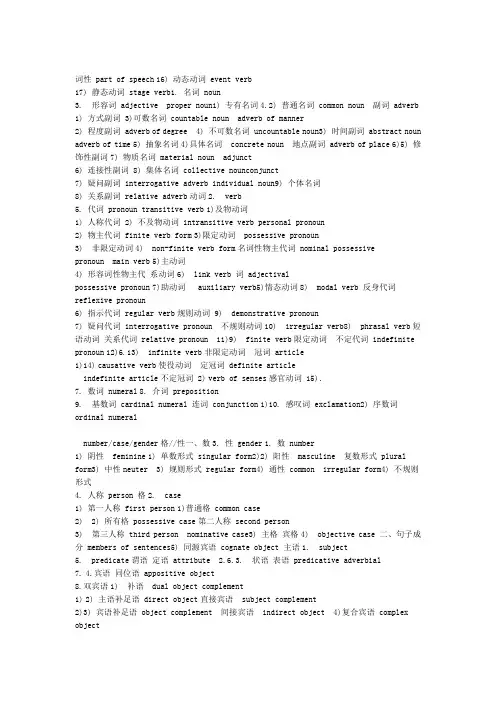
词性 part of speech16)动态动词 event verb17)静态动词 stage verb1.名词 noun3.形容词 adjective proper noun1)专有名词4.2)普通名词 common noun副词 adverb1)方式副词3)可数名词 countable noun adverb of manner2)程度副词 adverb of degree4)不可数名词 uncountable noun3)时间副词 abstract noun adverb of time5)抽象名词4)具体名词 concrete noun地点副词 adverb of place6)5)修饰性副词7)物质名词 material noun adjunct6)连接性副词8)集体名词 collective nounconjunct7)疑问副词 interrogative adverb individual noun9)个体名词8)关系副词 relative adverb动词2. verb5.代词 pronoun transitive verb1)及物动词1)人称代词2)不及物动词 intransitive verb personal pronoun2)物主代词 finite verb form3)限定动词 possessive pronoun3)非限定动词4) non-finite verb form名词性物主代词 nominal possessivepronoun main verb5)主动词4)形容词性物主代系动词6) link verb 词 adjectivalpossessive pronoun7)助动词 auxiliary verb5)情态动词8) modal verb反身代词reflexive pronoun6)指示代词 regular verb规则动词9) demonstrative pronoun7)疑问代词 interrogative pronoun不规则动词10) irregular verb8) phrasal verb短语动词关系代词 relative pronoun11)9) finite verb限定动词不定代词 indefinite pronoun12)6.13) infinite verb非限定动词冠词 article1)14)causative verb使役动词定冠词 definite articleindefinite article不定冠词2)verb of senses感官动词15).7.数词 numeral8.介词 preposition9.基数词 cardinal numeral连词 conjunction1)10.感叹词 exclamation2)序数词ordinal numeralnumber/case/gender格//性一、数3.性 gender1.数 number1)阴性 feminine1)单数形式 singular form2)2)阳性 masculine复数形式 plural form3)中性neuter3)规则形式 regular form4)通性 common irregular form4)不规则形式4.人称 person格2. case1)第一人称 first person1)普通格 common case2)2)所有格 possessive case第二人称 second person3)第三人称 third person nominative case3)主格宾格4) objective case二、句子成分 members of sentences5)同源宾语 cognate object主语1. subject5. predicate谓语定语 attribute 2.6.3.状语表语 predicative adverbial7.4.宾语同位语 appositive object8.双宾语1)补语 dual object complement1)2)主语补足语 direct object直接宾语 subject complement2)3)宾语补足语 object complement间接宾语 indirect object4)复合宾语 complex object三、句子 sentence (基本句型 basic sentence pattern)compound sentence并列句2. simple sentence简单句1.3.复合句 complex sentence4)反义疑问句 disjunctive question5)附加疑问句复合句 compound complextag question4.并列6)修辞疑问句 rhetorical question sentence7)5.感叹疑问句declarative sentence exclamatory question陈述句8.6.存在句 existential sentence 肯定句 positive sentence9.否定句 negative sentence7.疑问句 interrogative sentence10.祈使句 imperative sentence general question1)一般疑问句11.省略句 elliptical sentence特殊疑问句2) special question12.3)感叹句alternative question exclamatory sentence选择疑问句四、语气/语态语序 mood/voice/order/ii.部分倒装 partial inversion 1.语气 mood3)直接引语 direct speech indicative mood1)陈述语气4)间接引语 indirect speech祈使语气2) imperative mood5)自由直接引语 free direct speech3)虚拟语气 subjunctive mood6)语态2. voice自由间接引语 free indirect speech5. active voice主动语态一致 agreement1)1)主谓被动语态 passive voice一致 subject-predicate2)agreement3.否定 negation2)语法一致 grammatical agreement否定范围1) scope of negation3) full negation 全部否定概念一致 notional agreement2)4)3) partial negation局部否定就近原则principle of proximity5)4)转移否定强调 emphasis shift of negation6)语序 4. order重复 repetition6.1)自然语序语音 natural order pronunciation1)2) inversion倒装语序语调 tonerising tone声调2) full inversion全部倒装i.3)降调 falling tone12)层次 rank13)句子4)升降调 falling-rising tone sentence14)从句 clause7.文本 style15)词组 formal phrase1)正式文本9.非正式文本 informal词类 part of speech2)1)单词3)口语 spoken/oral English word2)实词套语4) formulistic expression notional word3)虚词 structural word5)英国英语 British English4)单纯词 simple word6)美国英语 American English5)派生词 derivative usage8.用法6)复合词 compound感情色彩1) emotional coloring10.句法关系 syntactic relationship commendatory2)褒义并列 coordinate3)贬义 derogatory1)从属 humorous4)幽默 subordination2)sarcastic modification修饰3)讽刺5)6) pre-modification4) ironic挖苦前置修饰 post-modification词性7) part of speech后置修饰5) restriction限制 grammar8)语法6) syntax双重限制double-restriction7)句法9)10) non-restriction morphology词法8)非限制11) structure结构五、从句 clause subordinate clause1.从属句 predicative clause表语从句2) coordinate clause并列句2.宾语从句 object clause3)名词性从句3.同位语从句 nominal clause appositive clause4) attributive clause定语从句 4. subject clause主语从句1).5.宾语从句 object clause purpose8)条件状语从句 adverbial clause of6.主语从句 subject clausecondition同位语从句 appositive clause7.i.真实条件状语从句 adverbial8.状语从句 adverbial clauseclause of real condition时间状语从句 adverbial clause of1)ii.非真实条件状语time从句adverbial clause of unreal 2)地点状语从句 adverbial clause ofcondition placeiii.方式状语从句3) adverbial clause of含蓄条件句 adverbial clauseof implied condition manneriv.错综条件句 adverbial clause 4)让步状语从句 adverbial clause ofof mixed conditionconcession9) adverbial clause of比较状语从句 adverbial clause of原因状语从句5)comparisoncauseadverbial clause of结果状语从句6)result adverbial clause of 7)目的状语从句六、时态 tense2)现在时1. present tense过去进行时 past continuous tense3)过去完成时1)一般现在时 present simple tense past perfect tense4)continuous 现在进行时2) present tense过去完成进行时 past perfectcontinuous tense present perfect tense现在完成时3)3.perfect将来时 future tense present 时进成完现4)在行1)一般将来时 future simple tense continuous tense2) past tense过去时 2.将来进行时 future continuous tensefuture perfect tense将来完成时3) past simple tense一般过去时1).4)将来完成进行时 future perfectcontinuous tense4.其他1)一般过去将来时 past future tense2)过去将来进行时 past futurecontinuous tense3)过去将来完成时 past future perfecttense4)过去将来完成进行时 past futureperfect continuous tense。
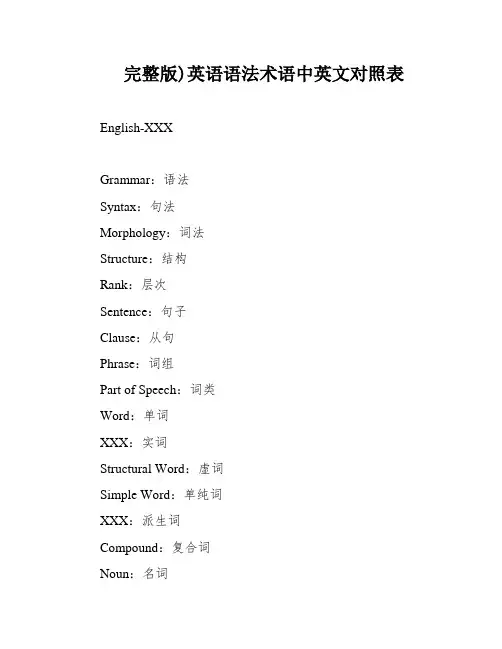
完整版)英语语法术语中英文对照表English-XXXGrammar:语法Syntax:句法Morphology:词法Structure:结构Rank:层次Sentence:句子Clause:从句Phrase:词组Part of Speech:词类Word:单词XXX:实词Structural Word:虚词Simple Word:单纯词XXX:派生词Compound:复合词Noun:名词Proper Noun:专有名词Common Noun:普通名词Countable Noun:可数名词Uncountable Noun:不可数名词Abstract Noun:抽象名词Concrete Noun:具体名词Material Noun:物质名词Collective Noun:集体名词Individual Noun:个体名词n:介词n:连词XXX:动词Main XXX:主动词XXX:及物动词Intransitive XXX:不及物动词Link XXX:系动词Auxiliary XXX:助动词Modal XXX:情态动词Regular Verb:规则动词Irregular Verb:不规则动词Phrasal XXX:短语动词XXX:限定动词Infinite XXX:非限定动词Causative Verb:使役动词Verb of Senses:感官动词Event Verb:动态动词XXX:静态动词XXX:感叹词Adjective:形容词Adverb:副词Adverb of Manner:方式副词Adverb of Degree:程度副词Adverb of Time:时间副词Adverb of Place:地点副词Adjunct:修饰性副词Conjunct:连接性副词Interrogative Adverb:疑问副词Relative Adverb:关系副词Pronoun:代词Personal Pronoun:人称代词Possessive Pronoun:物主代词Reflexive Pronoun:反身代词Reciprocal Pronoun:相互代词Demonstrative Pronoun:指示代词Pronouns are words used in place of nouns。
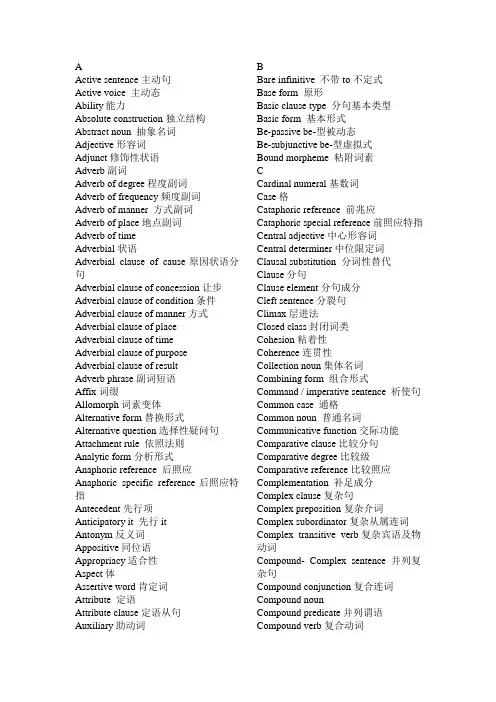
AActive sentence主动句Active voice 主动态Ability能力Absolute construction独立结构Abstract noun 抽象名词Adjective形容词Adjunct修饰性状语Adverb副词Adverb of degree程度副词Adverb of frequency频度副词Adverb of manner 方式副词Adverb of place地点副词Adverb of timeAdverbial状语Adverbial clause of cause原因状语分句Adverbial clause of concession让步Adverbial clause of condition条件Adverbial clause of manner方式Adverbial clause of placeAdverbial clause of timeAdverbial clause of purpose Adverbial clause of resultAdverb phrase副词短语Affix词缀Allomorph词素变体Alternative form替换形式Alternative question选择性疑问句Attachment rule 依照法则Analytic form分析形式Anaphoric reference 后照应Anaphoric specific reference后照应特指Antecedent先行项Anticipatory it 先行itAntonym反义词Appositive同位语Appropriacy适合性Aspect体Assertive word肯定词Attribute 定语Attribute clause定语从句Auxiliary助动词BBare infinitive 不带to不定式Base form 原形Basic clause type 分句基本类型Basic form 基本形式Be-passive be-型被动态Be-subjunctive be-型虚拟式Bound morpheme 粘附词素CCardinal numeral基数词Case格Cataphoric reference 前兆应Cataphoric special reference前照应特指Central adjective中心形容词Central determiner中位限定词Clausal substitution 分词性替代Clause分句Clause element分句成分Cleft sentence分裂句Climax层进法Closed class封闭词类Cohesion粘着性Coherence连贯性Collection noun集体名词Combining form 组合形式Command / imperative sentence 祈使句Common case 通格Common noun 普通名词Communicative function交际功能Comparative clause比较分句Comparative degree比较级Comparative reference比较照应Complementation 补足成分Complex clause复杂句Complex preposition复杂介词Complex subordinator复杂从属连词Complex transitive verb复杂宾语及物动词Compound- Complex sentence并列复杂句Compound conjunction复合连词Compound nounCompound predicate并列谓语Compound verb复合动词Concord一致Conditional条件句Conjunction连词Conjunction adverb连接副词Conjunct 连接性状语Content word实意词Contracted form缩写形式Coordinate element并列成分Coordinated subject并列结构做主语Coordinator并列连词Coreference pro-form指代词Correlative Coordinator关联并列连词Correlative subordinator关联从属连词DDangling participle悬垂分词Definite article定冠词Definite quantity确定数量Definite specific reference确定特指Demonstrative determiner指示限定词Demonstrative pronoun指示代词Dependent clause从属分句Derivational affix派生词缀Derivative派生词Determinative genitive限定词性属格Determiner限定词Direct speech直接引语Discontinuous modification分隔修饰Disjunct评注性状语Ditransitive verb双宾语及物动词v Double genitive双重属格Double negative双重否定Double relative clause双重关系分句Dynamic adjective动态形容词EEarlier time先时性Ellipsis省略Embedded relative clause嵌入式关系分句Emphasizer强调词Emphatic use强调性用法End focus句尾焦点End weight句尾重心Exclamation、exclamatory sentence感叹句Existential sentence存在句Explanatory adverb解说副词FFeminine gender阴性Finite clause限定分句Finite form限定形式Focal element中心成分Four-word preposition四词介词Fraction numeral分数词Free morpheme自由词素Fronting前置Full sentence完全句Function word功能此CGender性General question一般疑问句Genitive case属格Generic reference类指Gerund动名词Get-passiveGradable可等级的Grammatical concord语法一致Grammatical connector语法纽带Grammatical form语法形式HHead、headword中心词Historic present历史性现在时Hypothetical meaning假设意义IImperative mood祈使句Implied conditional含蓄条件句Indefinite article不定冠词Indefinite determiner不定限定词Independent clause独立分句Independent genitive独立属格Indicative mood陈述式Indirect speech间接引语Individual noun个体名词Infinitive不定式Inflectional affix屈折词缀Irregular plural不规则复数Interjection感叹词Interrogative determiner疑问限定词Intransitive verb不及物动词Inversion 倒装Inverted order倒装次序LLater time后时性Lexical connector词汇纽带Linking verb联系动词Locative adverbial地点状语Logical connector逻辑纽带MMarginal subordinator边际从属连词Masculine gender阳性Material noun物质名词Minor sentence不完全句Modal auxiliary情态助动词Modal idiom情态成语Modification修饰Mood式Morpheme词素Multiplicative numeral倍数词Multi-sentence-group text多语段语篇NNear-synonym近义词Neuter gender中性Nominal clause名词性分句Nominal genitive pronoun名词性属格代词Nominal substitution名词性替代Nominative absolute construction独立主格结构Non-finite form非限定Non-assertive word非肯定词Non-gradable adjective非等级形容词Non-restrictive relative clause非限制性分句Notional concord意义一致Notional subject实义主语Nucleus 调核OObject 宾语Object complement 宾语补语Object case宾格Obligation 义务Ordinal numeral序数词P Parallel平行、Partial negation局部否定Partitive 、unit noun单位词Passive sentence 被动句Past participle过去分词Past perfective progressive过去完成进行体Past tense form过去式Plural number复数Positive、absolute degree原级Possessive case所有格Possessive determiner物主限定词Postdeterminer后位限定词Postponement后置Predeterminer前卫限定词Predicate谓语Preposition介词Primary auxiliary基本助动词Principle of proximity就近原则Proper noun专业名词QQuantifier 量词Question、interrogative sentence疑问句Question tag 附加问句RReal conditional真实条件句Reciprocal pronoun相互代词Reference照应Referential meaning所致意义Reflexive form反身形式Rhetorical question修辞疑问句Root词根SStatement、declarative sentence陈述句Stative adjective静态形容词Subjective mood虚拟式Substitution替代Superlative degree最高级Supporting sentence辅助句Synonym同义词Synthetic form综合形式TTemporal adverbial时间状语Trailing sentence拖沓句Transitional word、phrase过度词语Transitive verb及物动词VVariant form变体形式Zero article零冠词。
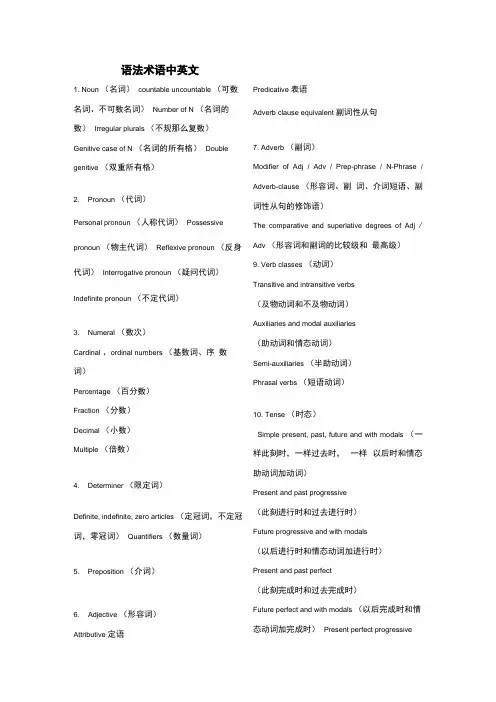
语法术语中英文1. Noun (名词)countable uncountable (可数名词、不可数名词)Number of N (名词的数)Irregular plurals (不规那么复数)Genitive case of N (名词的所有格)Double genitive (双重所有格)2.Pronoun (代词)Personal pronoun (人称代词)Possessive pronoun (物主代词)Reflexive pronoun (反身代词)Interrogative pronoun (疑问代词)Indefinite pronoun (不定代词)3.Numeral (数次)Cardinal 、ordinal numbers (基数词、序数词)Percentage (百分数)Fraction (分数)Decimal (小数)Multiple (倍数)4.Determiner (限定词)Definite, indefinite, zero articles (定冠词,不定冠词,零冠词)Quantifiers (数量词)5.Preposition (介词)6.Adjective (形容词)Attributive 定语Predicative 表语Adverb clause equivalent 副词性从句7. Adverb (副词)Modifier of Adj / Adv / Prep-phrase / N-Phrase / Adverb-clause (形容词、副词、介词短语、副词性从句的修饰语)The comparative and superlative degrees of Adj / Adv (形容词和副词的比较级和最高级)9. Verb classes (动词)Transitive and intransitive verbs(及物动词和不及物动词)Auxiliaries and modal auxiliaries(助动词和情态动词)Semi-auxiliaries (半助动词)Phrasal verbs (短语动词)10. Tense (时态)Simple present, past, future and with modals (一样此刻时,一样过去时,一样以后时和情态助动词加动词)Present and past progressive(此刻进行时和过去进行时)Future progressive and with modals(以后进行时和情态动词加进行时)Present and past perfect(此刻完成时和过去完成时)Future perfect and with modals (以后完成时和情态动词加完成时)Present perfect progressive(此刻完成进行时)Past perfect progressive (过去完成进行时)voice (被动语态)Passive voice in simple tense(被动语态的一样时态)Passive voice in perfect and progressive tenses (被动语态的完成和进行时态)Passive voice of phrasal verbs (短语动词的被动语态)12.Subjunctive mood (虚拟语气)13.To V (Infinitive 动词不定式)as subject, object and complement (用作主语,宾语和补足语)Indicating purpose / result (表示目的和结果)Modifying adjective (修饰形容词)as post modifier in a noun phrase (后位修饰名词)to be + V-ed2, to have + V-ed2, to be + V-ing (不定式的被动式,完成式和进行式)14.V-ing (Gerund 动名词)object, subject and predicative (宾语, 主语和表语)N / Pronouns or their possessive + V-ing as subject and object (名词/ 代词或其所有格加动名词作主语和宾语)Prep + N / Pronouns or their possessive + V-ing (介词加名词/代词或其所有格加动名词)being + V-ed2, having + V-ed2, having been + V-ed2 as a noun equivale nt (动名词的被动式,完成式和完成被动式起名词作用)15pre-modifier and post modifier in a noun phrase 此刻分词和过去分词)as complement (补足语)as an adverb clause equivalen t(作状语)When / while, etc. + V-ing / V-ed2 (When / While 等加此刻分词或过去分词)(with) N + V-ing / V-ed2 ( [ with ] 名词加此刻分词或过去分词)Dangling V-ing as adverb clause equivalen t(无归属此刻分词作状语)being + V-ed2, having + V-ed2, having been + V-ed2 as an adverb or adjective clause equivalen t(此刻分词的被动式、完成式和完成被动式作状语或定语)16. Basic sentence patterns and sentence elements (大体句型和句子成份)Pattern 1: S + VPattern 2: S + V + CsPattern 3: S + V + OPattern 4: S + V + Oi + OdPattern 5: S + V + Od + Co17. Interrogative form (疑问形式)Negative form (否定形式)Passive form (被动形式)relative clause (定语从句)Restrictive and non-restrictive (限制Pare nt hesis (插入语)Omission (省略)Omission through coordination (并列结构中的省略)Negation (否定)Total negation (全数否定)Partial negation (部份否定)Double negation (双重否定)Transferred negation (转移否定)性和非限制性定语从句)Appositive clause (同位语从句)Noun phrase appositive to clause(名词短语作句子的同位语)Clause of time and space(时刻从句和地址从句)Clauses of condition, concession and con tras t (条件从句、妥协从句和对照从句)Clauses of cause, result and purpose(缘故从句、结果从句和目的从句)Clauses of manner and comparison(方式从句和比较从句)Clauses of proportion and other types(比例从句和其它从句)3rd person pronouns, and plurals of the 1st and 2nd person pronouns (第三人称代词,第一、二人称代词的复数)indefinite pronouns (不定代词)(+ of + N / Pron)Subjec t-verb inversion(主语与谓语倒装)朗文高级英语语法》第一章动词时态概述(Overview Of Verb Tenses)1- 1 一样时态(The Simple Tenses)1- 2 进行时态(The ProgressiveTenses)31- 3 完成时态(The Perfect Tenses)1- 4 完成进行时态(The PerfectProgressive Tenses)1-5 时态用法总结(Summary Chart ofVerb Tenses)1- 6 -ing 和-ed 形式的拼写(Spelling of -ing and -ed Forms)第二章一样此刻时,一样过去时,此刻进行时和过去进行时(Present And Past,Simple And Progressive)2- 1 一样此刻时(Simple Present) 2- 2 此刻进行时(Present Progressive)2- 3 静态动词( Stative Verbs)2-5 规那么动词和不规那么动词(Regular and Irregular Verbs)2-6 规那么动词:-ed的发音(RegularVerbs: Pronunciation of -ed Endings)2-7 不规那么动词表(Irregular Verbs: an Alphabetical List)2-8 易混淆的动词:raise/rise, set/sit, lay/lie (Troublesome Verbs: raise/rise, set/sit, lay/lie)2-9 一样过去时(Simple Past)2-10 过去进行时(Past Progressive)2-11进行时态与always连用表示抱怨(Using Progressive Verbs with always to Complain)2-12 进行时态中地址状语的用法(Using Expressions of Place with Progressive Verbs) being + Adjective)3- 1 此刻完成时(Present Perfect)2-4 am/is/are being+形容词(am/is/are第三章完成时和完成进行时(Perfect And Perfect Progressive Tenses)3- 2 此刻完成进行时(Present Perfect Progressive) 3- 3 过去完成时(Past Perfect)3- 4 过去完成进行时(Past Perfect Progressive)第四章以后时(Future Time)4- 1 一样以后时:will 和be going to (Simple Future: will and be going to)4- 2 will 与be going to 的比较(will vs. be going to)4- 3 历时刻状语从句表示以后(Expressing the Future in Time Clauses)4-4 用一样此刻时和此刻进行时表示以后(Using the Present Progressive and the Simple Present to Express Future Time)4- 5 以后进行时(Future Progressive)4- 6 以后完成时(Future Perfect)4-7 以后完成进行时(Future Perfect Progressive)第五章时刻状语从句和时态的温习(Adverb Clauses Of Time And Review Of Verb Tenses)5- 1 时刻状语从句:形式(Adverb Clauses of Time: Form)5- 2 历时刻状语从句表示时刻关系(Using Adverb Clauses to Show Time Relationships)第六章主谓一致(Subject-verbAgreement)6-1以-s或-es结尾的词:用法、发音和拼写(Final -s/-es: Use, Pronunciation, and Spelling)6-2 大体的主谓一致问题(BasicSubject-verb Agreement)6-3 主谓一致:表达数量(Subject-verb Agreement: Using Expressions of Quantity)6-4 主谓一致:there be的用法(Subject-verb Agreement: Using there + be)6- 5 主谓一致:不规那么用法(Subject-verb Agreement: Some Irregularities)第七章名词(Nouns)7- 1 名词复数形式的规那么和不规那么转变(Regular and Irregular Plural Nouns)7- 2 所有格(Possessive Nouns)1037- 3 名词作修饰语(Using Nouns as Modifiers)7-4 可数名词和不可数名词(Count andNoncount Nouns)7- 5 不可数名词(Noncount Nouns)7- 6 常见不可数名词(Some Common Noncount Nouns)7-7 冠词的大体用法(Basic ArticleUsage)7-8 冠词用法的大体原那么(General Guidelines for Article Usage)7-9 数量的表达(Expressions of Quantity)7-10 a few 和few, a little 和little 的用法(Using a few and few; a little and little)7-11 带of 的数量表达(Using of in Expressions of Quantity)7-12 all (of)和both (of)〔All (of) and both (of) 7-13 单数的数量表达:one, each, every (Singular Expressions of Quantity: one, each, every)第八章代词(Pronouns)8- 1 人称代词(Personal Pronouns)8- 2 人称代词:与类属名词、不定代词的一致性(Personal Pronouns: Agreement with Generic Nouns and Indefinite Pronouns)8-3 人称代词:与集合名词的一致性(Personal Pronouns: Agreement with Collective Nouns)8- 4 反身代词(Reflexive Pronouns)8-5 you, one 和they 用作非人称代词(Using you, one, and they as Impersonal Pronouns)8- 6 other 的形式(Forms of other)8-7 other 的常见表达(CommonExpressions with other)第九章情态动词(一) (Modals, Part 1)9- 1 概述(Introduction)9-2 I作主语的礼貌请求(PoliteQuestions with I as the Subject)9-3 you 作主语的礼貌请求(PoliteQuestions with you as the Subject)9- 4 would you mind 用作礼貌请求(Polite Requests with would you mind)9- 5 表示必需:must, have to, have got to (Expressing Necessity: must, have to, have got to)9-6 没必要要和禁止:have to和must的否定形式(Lack of Necessity and Prohibition: have to and must in the Negative)9-7 忠告:should, ought to, had better (Advisability: should, ought to, had better)9-8 should 的过去式(The Past Form of should)9-9 期望:be supposed to (Expec tatio ns: be supposed to)9-10 提议:let's, why don't, shall I/we(Making Suggestions: let's, why don't, shall I/we)9-11 提议:could与should的比较(Making Suggestions: could vs. should) 第十章情态动词(二) (Modals, Part 2)10- 1 表示确信程度:此刻时(Degrees of Certainty: Present Time)10-2 表示确信程度:此刻时的否定形式(Degrees of Certainty: Present Time Negative)10-3 表示确信程度:过去时(Degrees of Certainty: Past Time)10-4 表示确信程度:以后时(Degrees of Certainty: Future Time)10-5 情态动词的进行式(Progressive Forms of Modals)10-6 表示能力:can 和could (Ability:can and could)10-7 would 表示过去重复性的动作(Using would to Express a RepeatedAction in the Past)10-8 表示偏向: would rather(Expressing Preference: would rather)10-9 情态动词和短语情态动词的结合(Combining Modals with Phrasal Modals)10-10 情态动词和类似表达的总结表(Summary Chart of Modals and Similar Expressions)第十一章被动语态(The Passive)11-1 被动语态的组成(Forming the Passive)11-2 被动语态的用法(Using thePassive)11-3 间接宾语用作被动语态的主语(Indirect Objects Used as Passive Subjects)11-4 情态动词与短语情态动词的被动语态(The Passive Form of Modals and Phrasal Modals)11-5 静态被动语态(Stative Passive)11-6 常见静态被动语态动词 + 介词(Common Stative Passive Verbs + Prepositions)11-7 get 与被动语态(The Passive with get) 11-8 分词形容词(Participial Adjectives)第十二章名词性从句(Noun Clauses)12-1 概述(Introduction)12-2 以疑问词开头的名词性从句(Noun Clauses Beginning with a Question Word)12-3以whether或if开头的名词性从句(Noun Clauses Beginning with whether or if)12-4疑问词后接不定式(Ques tion Words Followed by Infinitives)12-5 以that 开头的名词性从句(NounClauses Beginning with that)12-6 直接引语(Quoted Speech)12-7 间接引语:名词性从句中动词的形式(Reported Speech: Verb Forms in Noun Clauses)12-8 名词性从句中虚拟语气的用法(Using the Subjunctive in Noun Clauses)12-9 带有-ever的辞汇的用法(Using -ever Words)第十三章定语从句(Adjective Clauses)13- 1 概述(Introduction)13-2 定语从句的关系代词作主语(Adjective Clause Pronouns Used as the Subject)13-3 定语从句的关系代词作动词的宾语(Adjective Clause Pronouns Used as the Object of a Verb)13-4 定语从句的关系代词作介词的宾语(Adjective Clause Pronouns Used as the Object of a Preposition)13-5 定语从句的经常使用句型(UsualPatterns of Adjective Clauses)13-6 whose 的用法(Using whose)13-7定语从句中where的用法(Using where in Adjective Clauses)13-8 定语从句中when的用法(Using when in Adjective Clauses)13-9 定语从句修饰代词的用法(Using Adjective Clauses to Modify Pronouns)13-10 定语从句中标点符号的利用(Punctuating Adjective Clauses) 13-11 定语从句中数量的表示方式(Using Expressions of Quantity in Adjective Clauses)13-12 名词+of which 的用法(U sing Noun + of which)28613-13 which修饰整个句子的用法(Using which to Modify a Whole Sentence)28613-14 将定语从句简化为形容词短语:概述(Reducing Adjective Clauses to Adjective Phrases: Introduction)13-15 将定语从句转变成形容词短语(Changing an Adjective Clause to an Adjective Phrase)第十四章动名词和不定式(一) (GerundsAnd Infinitives, Part 1)14- 1 动名词:概述(Gerunds: Introduction)14-2 动名词作介词的宾语(Using Gerunds as the Objects of Prepositions)14-3 后面接动名词的常见介词短语(Common Preposition CombinationsFollowed by Gerunds)14-4 后面接动名词的常见动词(CommonVerbs Followed by Gerunds)14-5 go+动名词(go + Gerund)14-6后面接动词-ing形式的固定搭配(Special Expressions Followed by -ing)14-7 后面接不定式的常见动词(CommonVerbs Followed by Infinitives)14-8 后面既可接不定式又可接动名词的常见动词(Common Verbs Followed by either Infinitives or Gerunds)14-9 后面接动名词的动词列表(Reference List of Verbs Followed byGerunds) 14-10 后面接不定式的动词列表(Reference List of Verbs Followed by Infinitives)14-11 it +不定式;动名词和不定式作主语(it + Infinitive; Gerunds and Infinitives as Subjects) And Infinitives, Part 2)15-1 表示目的的不定式:in order to (Infinitive of Purpose: in order to)15-2 后面接不定式的形容词(Adjectives Followed by Infinitives)15-3 不定式与too和enough连用(Using Infinitives with too and enough)15-4 不定式和动名词的被动语态和完成式(Passive and Past Forms of Infinitives and Gerunds)15-5 need 后接动名词或不定式的被动语态形式(Using Gerunds or Passive Infinitives Following need)15-6 所有格修饰动名词(Using a Possessive to Modify a Gerund)15-7 感官动词的用法(Using Verbs of Perception)15-8 let和help后接动词原形(Using the Simple Form after let and help)15-9 使役动词的用法:make, have, get(Using Causative Verbs: make, have, get)第十五章动名词和不定式(二) (Gerunds第十六章并列连词(Coordinating16-1 平行结构(Parallel Structure)16-2 成对连词:both・・・and; not only… but also; either … or; neither … nor (Using Paired Conjunctions: both . . . and; not only . . . but also; either . . . or; neither . . . nor)16- 3 用并列连词连接独立分句(Combining Independent Clauses with Coordinating Conjunctions)第十七章状语从句(Adverb Clauses)17- 1 概述(In troduc tion)17-2 缘故状语从句(Using Adverb Clauses to Show Cause and Effect)17-3表达对照(意外的结果):even though 的用法〔Expressing Contrast (Unexpected Result): Using even though〕17-4 表达直接对照:while和whereas (Showing Direct Contrast: while and whereas)17-5条件状语从句:if从句(Expressing Conditions in Adverb Clauses: 17-6 条件状语从句:whether or not和even if 的用法(Adverb Clauses of Condition: Using whether or not and even if)17-7 条件状语从句:in case和in the event that 的用法(Adverb Clauses of Condition: Using in case and in the event that)17-8 条件状语从句:unless的用法(Adverb Clauses of Condition: Using unless)17-9 条件状语从句:only if的用法(Adverb Clauses of Condition: Using only if)第十八章将状语从句简化为修饰性的副词短语(Reduction Of Adverb Clauses To Modifying Adverbial Phrases)18- 1 概述(In troduc tion)18-2 将时刻状语从句简化为修饰性的副词短语(Changing Time Clauses to Modifying Adverbial Phrases)18-3 用修饰性的副词短语表达“与此同时”的概念(Expressing the Idea of “During the Same Time” in Modifying Adverbial Phrases)18-4 用修饰性的副词短语表示因果关系(Expressing Cause and Effect in Modifying Adverbial Phrases)18-5 在修饰性的副词短语中利用“upon + -ing” (Using upon + -ing in Modifying Adverbial Phrases)第十九章表示因果、对照和条件关系的关联词(Connectives That Express Cause And Effect, Contrast, And Condition)19-1 because of 和due to 的用法(Using because of and due to)19-2用过渡词表示因果关系:therefore 和consequently (Using Transitions to Show Cause and Effect: therefore and consequently)19-3 句型和标点符号小结(Summary ofPatterns and Punctuation)19-4其它表示因果关系的方式:such… that 和so …that (Other Ways of Expressing Cause and Effect: such . . . that and so . . . that)19-5 表示目的:so that的用法(Expressing Purpose: Using so that)19-6 表示对照(意料之外的结果) 〔Showing Contrast (Unexpected Result)〕19-7 表示直接对照(Showing Direct Contrast)19-8 表示条件:otherwise 和or (else) 的用法〔Expressing Conditions: Using otherwise and or (else)〕19-9 关联词小结:因果、对照和条件关系(Summary of Connectives: Cause and Effect, Contrast, Condition)第二十章条件句和表达愿望的方式(Conditional Sentences And Wishes)20- 1 条件句中一样动词形式概述(Overview of Basic Verb Forms Used in Conditional Sentences)20-2 此刻和以后的真实条件句(True in the Present or Future)20-3 此刻和以后的非真实条件句(与事实相反)〔Untrue (Contrary to Fact) in the Present or Future〕20-4 过去的非真实条件句 (与事实相反) 〔Untrue (Contrary to Fact) in the Past〕20-5 在条件句中利用动词的进行时形式(Using Progressive Verb Forms in Conditional Sentences)20-6条件句中“混合时刻”的用法(Using“ Mixed Time ” in ConditionalSentences)42420-7 if 的省略(Omitting if)20-8 暗含的条件(Implied Cond it ions)20-9 as if / as though 的用法(Using as if/as though) 20-10 wish后面的动词形式(Verb Forms Following wish)20-11 用would 表达关于以后的希望(Using would to Make Wishes about the Future)434and Objects)A-2 介词和介词短语(Prepositions and Prepositional Phrases) A-3 形容词(Adjectives)A-4 副词(Adverbs)A-5 be 动词(The Verb be)A-6 系动词(Linking Verbs)B单元:疑问句(Questions)B-1 一样疑问句和特殊疑问句的形式(Forms of Yes/No and Information Questions)B-2 疑问词(Ques tion Words)B-3 简化的一样疑问句(Shortened Yes/No Questions)B-4 否定疑问句(Negative Questions) B-5 反意疑问句(Tag Questions)附录增补语法单元(Supplementary Grammar Units)A 单元:大体语法术语(Basic GrammarTerminology)C 单元:缩写(Contractions) D单元:否定句(Negatives)D-1 not与其它否定词的用法(Using not and Other Negative Words)A-1 主语、动词和宾语(Subjects, Verbs,D-2 幸免“重复两次否定” (Avoiding Double Negatives)D-3 以否定词开头的句子(Beginning a Sentence with a Negative Word)E 单元:介词搭配(Preposition Combinations)E 形容词和动词的介词搭配(Preposition Combinations withAdjectives and Verbs)F 单元:用来举例和延续观点的关联词(Connectives To Give Examples And To Continue An Idea)F-1 用来举例的关联词(Connectives to Give Examples)F-2 用来延续观点的关联词(Connectives to Continue the Same Idea)G 单元:动词形式的回忆练习(Verb Form Review Exercises)。
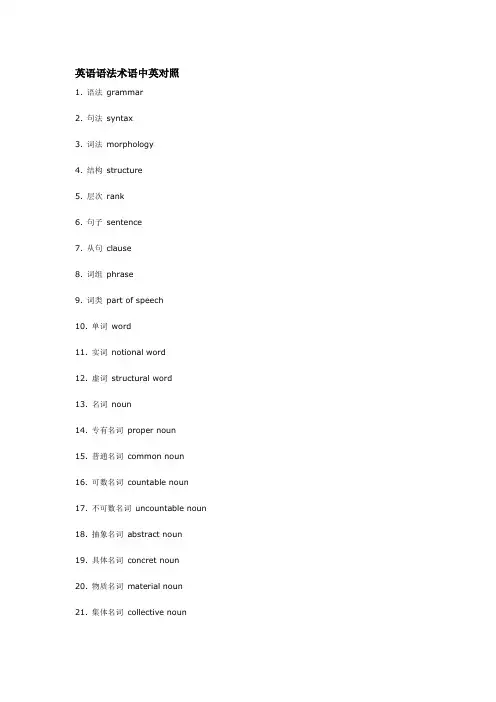
英语语法术语中英对照1. 语法grammar2. 句法syntax3. 词法morphology4. 结构structure5. 层次rank6. 句子sentence7. 从句clause8. 词组phrase9. 词类part of speech10. 单词word11. 实词notional word12. 虚词structural word13. 名词noun14. 专有名词proper noun15. 普通名词common noun16. 可数名词countable noun17. 不可数名词uncountable noun18. 抽象名词abstract noun19. 具体名词concret noun20. 物质名词material noun21. 集体名词collective noun22. 个体名词individual noun23. 介词preposition24. 连词conjunction25. 动词verb26. 主动词main verb27. 及物动词transitive verb28. 不及物动词intransitive verb29. 系动词link verb30. 助动词auxiliary verb31. 情态动词modal verb32. 规则动词regular verb33. 不规则动词irregular verb34. 短语动词phrasal verb35. 限定动词finite verb36. 非限定动词infinite verb37. 使役动词causative verb38. 感官动词verb of senses39. 动态动词event verb40. 静态动词state verb41. 感叹词exclamation42. 形容词adjective43. 副词adverb44. 方式副词adverb of manner45. 程度副词adverb of degree46. 时间副词adverb of time47. 地点副词adverb of place48. 修饰性副词adjunct49. 连接性副词conjunct50. 疑问副词interrogative adverb51. 关系副词relative adverb52. 代词pronoun53. 人称代词personal pronoun54. 物主代词possessive pronoun55. 反身代词reflexive pronoun56. 相互代词reciprocal pronoun57. 指示代词demonstrative pronoun58. 疑问代词interrogative pronoun59. 关系代词relative pronoun60. 不定代词indefinite pronoun61. 物主代词possessive pronoun62. 名词性物主代词nominal possessive pronoun63. 形容词性物主代词adjectival possessive pronoun64. 冠词article65. 定冠词definite article66. 不定冠词indefinite article67. 数词numeral68. 基数词cardinal numeral69. 序数词ordinal numeral70. 分数词fractional numeral71. 形式form72. 单数形式singular form73. 复数形式plural form74. 限定动词finite verb form75. 非限定动词non-finite verb form76. 原形base form77. 从句clause78. 从属句subordinate clause79. 并列句coordinate clause80. 名词从句nominal clause81. 定语从句attributive clause82. 状语从句adverbial clause83. 宾语从句object clause84. 主语从句subject clause85. 同位语从句appositive clause86. 时间状语从句adverbial clause of time87. 地点状语从句adverbial clause of place88. 方式状语从句adverbial clause of manner89. 让步状语从句adverbial clause of concession90. 原因状语从句adverbial clause of cause91. 结果状语从句adverbial clause of result92. 目的状语从句adverbial clause of purpose93. 条件状语从句adverbial clause of condition94. 真实条件状语从句adverbial clause of real condition95. 非真实条件状语从句adverbial clause of unreal condition96. 含蓄条件句adverbial clause of implied condition97. 错综条件句adverbial clause of mixed condition98. 句子sentence99. 简单句simple sentence100. 并列句compound sentence101. 复合句complex sentence102. 并列复合句compound complex sentence103. 陈述句declarative sentence104. 疑问句interrogative sentence105. 一般疑问句general question106. 特殊疑问句special question107. 选择疑问句alternative question108. 附加疑问句tag question109. 反义疑问句disjunctive question110. 修辞疑问句rhetorical question 111. 感叹疑问句exclamatory question 112. 存在句existential sentence 113. 肯定句positive sentence114. 否定句negative sentence115. 祈使句imperative sentence 116. 省略句elliptical sentence117. 感叹句exclamatory sentence 118. 基本句型basic sentence pattern 119. 句子成分members of sentences 120. 主语subject121. 谓语predicate122. 宾语object123. 双宾语dual object124. 直接宾语direct object125. 间接宾语indirect object126. 复合宾语complex object127. 同源宾语cognate object128. 补语complement129. 主补subject complement130. 宾补object complement131. 表语predicative132. 定语attribute133. 同位语appositive134. 状语adverbial135. 句法关系syntatic relationship 136. 并列coordinate137. 从属subordination138. 修饰modification139. 前置修饰pre-modification 140. 后置修饰post-modification 141. 限制restriction142. 双重限制double-restriction 143. 非限制non-restriction144. 数number145. 单数形式singular form 146. 复数形式plural form147. 规则形式regular form148. 不规则形式irregular form 149. 格case150. 普通格common case151. 所有格possessive case 152. 主格nominative case153. 宾格objective case154. 性gender155. 阳性masculine156. 阴性feminine157. 通性common158. 中性neuter159. 人称person160. 第一人称first person161. 第二人称second person162. 第三人称third person163. 时态tense164. 过去将来时past future tense165. 过去将来进行时past future continuous tense 166. 过去将来完成时past future perfect tense 167. 一般现在时present simple tense168. 一般过去时past simple tense169. 一般将来时future simple tense170. 现在完成时past perfect tense171. 过去完成时present perfect tense172. 将来完成时future perfect tense173. 现在进行时present continuous tense 174. 过去进行时past continuous tense175. 将来进行时future continuous tense176. 过去将来进行时past future continuous tense 177. 现在完成进行时present perfect continuous tense 178. 过去完成进行时past perfect continuous tense 179. 语态voice180. 主动语态active voice181. 被动语态passive voice182. 语气mood183. 陈述语气indicative mood184. 祈使语气imperative mood185. 虚拟语气subjunctive mood186. 否定negation187. 否定范围scope of negation188. 全部否定full negation189. 局部否partial negation190. 转移否定shift of negation191. 语序order192. 自然语序natural order193. 倒装语序inversion194. 全部倒装full inversion195. 部分倒装partial inversion196. 直接引语direct speech197. 间接引语indirect speech198. 自由直接引语free direct speech 199. 自由间接引语free indirect speech 200. 一致agreement201. 主谓一致subject-predicate agreement 202. 语法一致grammatical agreement 203. 概念一致notional agreement204. 就近原则principle of proximity205. 强调emphasis206. 重复repetition207. 语音pronunciation208. 语调tone209. 升调rising tone210. 降调falling tone211. 降升调falling-rising tone212. 文体style213. 正式文体formal214. 非正式文体informal215. 口语spoken/oral English216. 套语formulistic expression217. 英国英语British English218. 美国英语American English219. 用法usage220. 感情色彩emotional coloring 221. 褒义commendatory222. 贬义derogatory223. 幽默humorous224. 讽刺sarcastic225. 挖苦ironic226. 英语修辞手法:一、明喻(simile)二、隐喻(metaphor)三、提喻(synecdoche)四、拟人(personification)五、夸张(hyperbole)六、叠言(rhetorical repetition)七、借代(metonymy)八、双关语(pun)九、拟声(onomatcpocia)十、讽刺(irony)十一、通感(synesthesia)十二、头韵法(alliteration)。
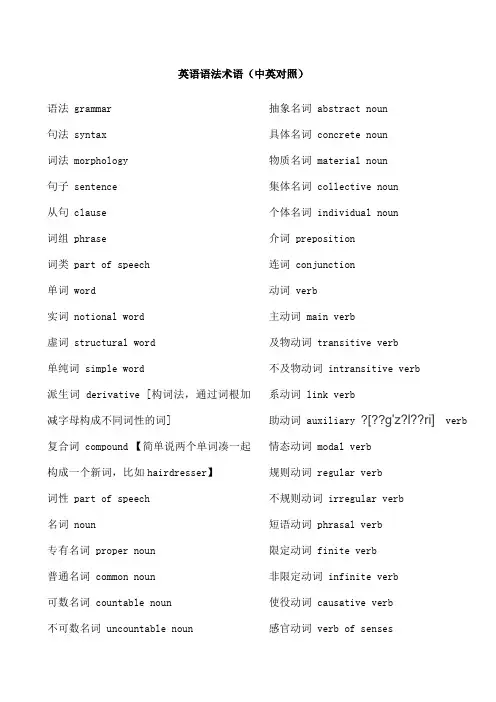
英语语法术语(中英对照)语法 grammar句法 syntax词法 morphology句子 sentence从句 clause词组 phrase词类 part of speech单词 word实词 notional word虚词 structural word单纯词 simple word派生词 derivative [构词法,通过词根加减字母构成不同词性的词]复合词 compound 【简单说两个单词凑一起构成一个新词,比如hairdresser】词性 part of speech名词 noun专有名词 proper noun普通名词 common noun可数名词 countable noun不可数名词 uncountable noun 抽象名词 abstract noun具体名词 concrete noun物质名词 material noun集体名词 collective noun个体名词 individual noun介词 preposition连词 conjunction动词 verb主动词 main verb及物动词 transitive verb不及物动词 intransitive verb系动词 link verb助动词 auxiliary ?[??ɡ'z?l??ri] verb 情态动词 modal verb规则动词 regular verb不规则动词 irregular verb短语动词 phrasal verb限定动词 finite verb非限定动词 infinite verb使役动词 causative verb感官动词 verb of senses动态动词 event verb或者dynamic verbs(动态动词)静态动词 state /stative verb感叹词 exclamation形容词 adjective原级 positive比较级 comparative最高级 superlative副词 adverb方式副词 adverb of manner程度副词 adverb of degree时间副词 adverb of time地点副词 adverb of place修饰性副词 adjunct连接性副词 conjunct疑问副词 interrogative [,?nt?'rɑɡ?t?v] adverb关系副词 relative adverb代词 pronoun人称代词 personal pronoun物主代词 possessive pronoun反身代词 reflexive pronoun相互代词reciprocal?[r?'s?pr?k(?)l] pronoun指示代词 demonstrative pronoun 疑问代词 interrogative pronoun关系代词 relative pronoun不定代词 indefinite pronoun物主代词 possessive pronoun名词性物主代词nominal possessive pronoun形容词性物主代词 adjectival possessive pronoun冠词 article定冠词 definite article不定冠词 indefinite article数词 numeral基数词 cardinal numeral序数词 ordinal numeral分数词 fractional numeral形式 form单数形式 singular form复数形式 plural form限定动词 finite verb form非限定动词 non-finite verb form原形 base form从句 clause从属句 subordinate clause并列句coordinate clause名词从句nominal clause定语从句attributive clause状语从句adverbial clause宾语从句object clause主语从句subject clause同位语从句appositive clause时间状语从句adverbial clause of time地点状语从句adverbial clause of place方式状语从句adverbial clause of manner让步状语从句adverbial clause of concession原因状语从句adverbial clause of cause结果状语从句adverbial clause of result目的状语从句adverbial clause of purpose条件状语从句adverbial clause of condition真实条件状语从句adverbial clause of real condition非真实条件状语从句adverbial clause of unreal condition含蓄条件句adverbial clause of implied condition错综条件句adverbial clause of mixed condition句子sentence简单句simple sentence并列句compound sentence复合句complex sentence并列复合句compound complex sentence陈述句declarative sentence疑问句interrogative sentence一般疑问句general question特殊疑问句special question选择疑问句alternative question附加疑问句tag question 反义疑问句disjunctive question 修辞疑问句rhetorical question 感叹疑问句exclamatory question 存在句existential sentence肯定句positive sentence基本句型basic sentence pattern 否定句negative sentence祈使句imperative sentence省略句elliptical sentence感叹句exclamatory sentence句子成分members of sentences 主语subject谓语predicate宾语object双宾语dual object直接宾语direct object间接宾语indirect object复合宾语complex object同源宾语cognate object补语complement主补subject complement宾补object complement表语predicative定语attribute同位语appositive状语adverbial句法关系syntactic relationship 并列coordinate从属subordination修饰modification前置修饰pre-modification 后置修饰post-modification 限制restriction双重限制double-restriction 非限制non-restriction数number单数形式singular form复数形式plural form规则形式regular form不规则形式irregular form 格case普通格common case所有格possessive case主格nominative case宾格objective case性gender阳性masculine阴性feminine通性common中性neuter人称person第一人称first person第二人称second person第三人称third person时态tense过去将来时past future tense 过去将来进行时past future continuous tense过去将来完成时past future perfect tense一般现在时present simple tense一般过去时past simple tense一般将来时future simple tense现在完成时present perfect tense过去完成时past perfect tense将来完成时future perfect tense现在进行时present continuous tense过去进行时past continuous tense将来进行时future continuous tense过去将来进行时past future continuous tense现在完成进行时present perfect continuous tense 过去完成进行时past perfect continuous tense语态voice主动语态active voice被动语态passive voice语气mood陈述语气indicative mood祈使语气imperative mood虚拟语气subjunctive mood否定negation否定范围scope of negation全部否定full negation局部否定partial negation转移否定shift of negation语序order自然语序natural order倒装语序inversion全部倒装full inversion部分倒装partial inversion直接引语direct speech间接引语indirect speech自由直接引语free direct speech自由间接引语free indirect speech一致agreement主谓一致subject-predicate agreement 语法一致grammatical agreement概念一致notional agreement就近原则principle of proximity强调emphasis重复repetition语音pronunciation语调tone升调rising tone降调falling tone 降升调falling-rising tone文体style结构structure层次rank正式文体formal非正式文体informal口语?spoken/oral English套语formulistic expression 用法usage感情色彩emotional coloring 褒义commendatory贬义derogatory幽默humorous讽刺sarcastic挖苦ironic英国英语?British English美国英语American English。
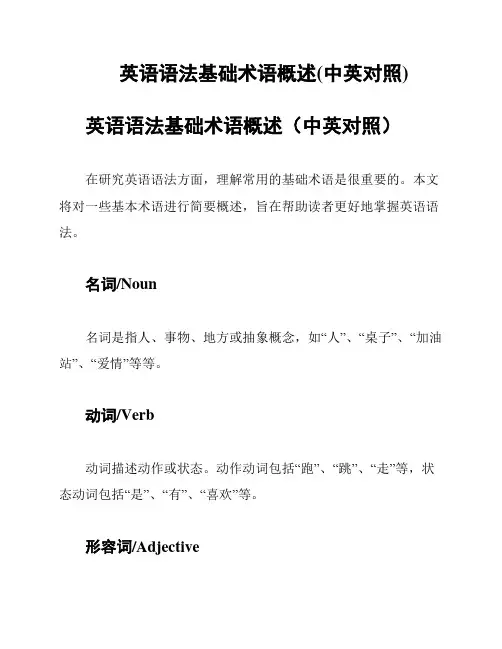
英语语法基础术语概述(中英对照)英语语法基础术语概述(中英对照)
在研究英语语法方面,理解常用的基础术语是很重要的。
本文将对一些基本术语进行简要概述,旨在帮助读者更好地掌握英语语法。
名词/Noun
名词是指人、事物、地方或抽象概念,如“人”、“桌子”、“加油站”、“爱情”等等。
动词/Verb
动词描述动作或状态。
动作动词包括“跑”、“跳”、“走”等,状态动词包括“是”、“有”、“喜欢”等。
形容词/Adjective
形容词用于描述名词或代词,如“美丽的”、“晴朗的”、“重要的”。
副词/Adverb
副词用于描述动词、形容词、其他副词和整个句子的意义,如“快速地”、“非常”、“可能”等。
代词/Pronoun
代词用于替代名词,以避免重复,如“他”、“她”、“它”等。
冠词/Article
冠词用于限定名词,并指明其在句子中的身份,包括“a/an”和“the”。
介词/Preposition
介词用于表达位置、方向、时间、方式和目的,如“在”、“到”、“在...之前”、“以...的方式”等。
连词/Conjunction
连词用于连接句子或句子的不同部分,包括“and”,“but”,“or”等。
感叹词/Interjection
感叹词用于表达情感、愤怒或惊讶,并不与其他部分相关,如“哦”、“嗨”等。
以上就是英语语法基础术语的简要概述。
希望本文能对您的英
语语法学习有所帮助。
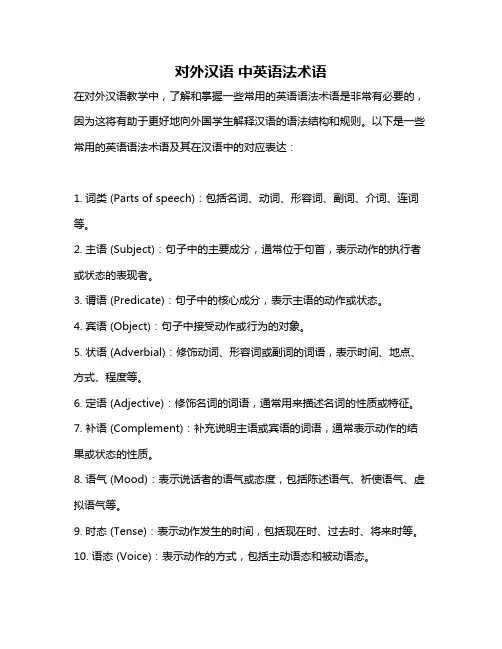
对外汉语中英语法术语
在对外汉语教学中,了解和掌握一些常用的英语语法术语是非常有必要的,因为这将有助于更好地向外国学生解释汉语的语法结构和规则。
以下是一些常用的英语语法术语及其在汉语中的对应表达:
1. 词类 (Parts of speech):包括名词、动词、形容词、副词、介词、连词等。
2. 主语 (Subject):句子中的主要成分,通常位于句首,表示动作的执行者或状态的表现者。
3. 谓语 (Predicate):句子中的核心成分,表示主语的动作或状态。
4. 宾语 (Object):句子中接受动作或行为的对象。
5. 状语 (Adverbial):修饰动词、形容词或副词的词语,表示时间、地点、方式、程度等。
6. 定语 (Adjective):修饰名词的词语,通常用来描述名词的性质或特征。
7. 补语 (Complement):补充说明主语或宾语的词语,通常表示动作的结果或状态的性质。
8. 语气 (Mood):表示说话者的语气或态度,包括陈述语气、祈使语气、虚拟语气等。
9. 时态 (Tense):表示动作发生的时间,包括现在时、过去时、将来时等。
10. 语态 (Voice):表示动作的方式,包括主动语态和被动语态。
以上只是一些基本的英语语法术语,实际上还有很多更具体和专业的术语,如分词、不定式、从句等等。
在对外汉语教学中,教师需要根据学生的实际需求和学习水平,选择适当的术语进行解释和教学。
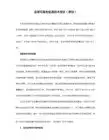
英语语法术语语法grammar句法syntax词法morphology句子sentence从句clause词组phrase词类part of speech单词word实词notional word虚词structural word单纯词simple word派生词derivative复合词compound词性part of speech名词noun专有名词proper noun普通名词common noun可数名词countable noun不可数名词uncountable noun 抽象名词abstract noun具体名词concret noun物质名词material noun集体名词collective noun个体名词individual noun介词preposition连词conjunction动词verb主动词main verb及物动词transitive verb不及物动词intransitive verb 系动词link verb助动词auxiliary verb情态动词modal verb规则动词regular verb不规则动词irregular verb短语动词phrasal verb限定动词finite verb非限定动词infinite verb使役动词causative verb感官动词verb of senses动态动词event verb静态动词state verb感叹词exclamation形容词adjective 原级positive比较级comparative最高级superalative副词adverb方式副词adverb of manner程度副词adverb of degree时间副词adverb of time地点副词adverb of place修饰性副词adjunct连接性副词conjunct疑问副词interogative adverb关系副词relative adverb代词pronoun人称代词personal pronoun物主代词possesive pronoun反身代词reflexive pronoun相互代词reciprocal pronoun指示代词demonstrative pronoun疑问代词interrogative pronoun关系代词relative pronoun不定代词indefinite pronoun物主代词possecive pronoun名词性物主代词nominal possesive prnoun形容词性物主代词adjectival possesive pronoun 冠词article定冠词definite article不定冠词indefinite article数词numeral基数词cardinal numeral序数词ordinal numeral分数词fractional numeral形式form单数形式singular form复数形式plural form限定动词finite verb form非限定动词non-finite verb form原形base form从句clause从属句subordinate clause并列句coordinate clause名词从句nominal clause定语从句attributive clause状语从句adverbial clause宾语从句object clause主语从句subject clause同位语从句appositive clause时间状语从句adverbial clause of time地点状语从句adverbial clause of place方式状语从句adverbial clause of manner让步状语从句adverbial clause of concession原因状语从句adverbial clause of cause结果状语从句adverbial clause of result目的状语从句adverbial clause of purpose条件状语从句adverbial clause of condition真实条件状语从句adverbial clause of real condition非真实条件状语从句adverbial clause of unreal condition含蓄条件句adverbial clause of implied condition错综条件句adverbial clause of mixed condition 句子sentence简单句simple sentence并列句compound sentence复合句complex sentence并列复合句compound complex sentence陈述句declarative sentence疑问句interrogative sentence一般疑问句general question特殊疑问句special question选择疑问句alternative question附加疑问句tag question反义疑问句disjunctive question修辞疑问句rhetorical question感叹疑问句exclamatory question存在句existential sentence肯定句positive sentence基本句型basic sentence pattern否定句negative sentence祈使句imperative sentence省略句elliptical sentence感叹句exclamatory sentence句子成分members of sentences主语subject谓语predicate宾语object双宾语dual object直接宾语direct object间接宾语indirect object复合宾语complex object同源宾语cognate object补语complement 主补subject complement宾补object complement表语predicative定语attribute同位语appositive状语adverbial句法关系syntactic relationship并列coordinate从属subordination修饰modification前置修饰pre-modification后置修饰post-modification限制restriction双重限制double-restriction非限制non-restriction数number单数形式singular form复数形式plural form规则形式regular form不规则形式irregular form格case普通格common case所有格possessive case主格nominative case宾格objective case性gender阳性masculine阴性feminine通性common中性neuter人称person第一人称first person第二人称second person第三人称third person时态tense过去将来时past future tense过去将来进行时past future continuous tense 过去将来完成时past future perfect tense一般现在时present simple tense一般过去时past simple tense一般将来时future simple tense现在完成时present perfect tense过去完成时past perfect tense将来完成时future perfect tense现在进行时present continuous tense过去进行时past continuous tense将来进行时future continuous tense过去将来进行时past future continuous tense现在完成进行时present perfect continuous tense 过去完成进行时past perfect continuous tense语态voice主动语态active voice被动语态passive voice语气mood陈述语气indicative mood祈使语气imperative mood虚拟语气subjunctive mood否定negation否定范围scope of negation全部否定full negation局部否定partial negation转移否定shift of negation语序order自然语序natural order倒装语序inversion全部倒装full inversion部分倒装partial inversion直接引语direct speech间接引语indirect speech自由直接引语free direct speech自由间接引语free indirect speech一致agreement主谓一致subject-predicate agreement语法一致grammatical agreement概念一致notional agreement就近原则principle of proximity强调emphasis重复repetition语音pronunciation语调tone升调rising tone降调falling tone降升调falling-rising tone文体style结构structure层次rank正式文体formal非正式文体informal口语spoken/oral English套语formulistic expression用法usage感情色彩emotional coloring褒义commendatory贬义derogatory幽默humorous讽刺sarcastic 挖苦ironic英国英语British English美国英语American English。
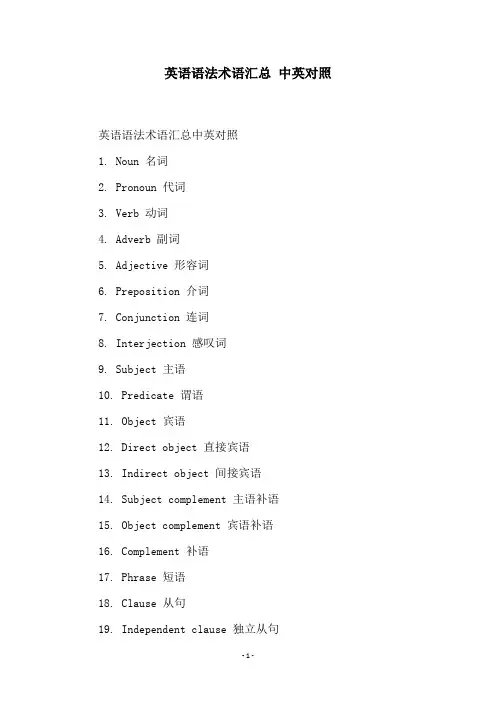
英语语法术语汇总中英对照英语语法术语汇总中英对照1. Noun 名词2. Pronoun 代词3. Verb 动词4. Adverb 副词5. Adjective 形容词6. Preposition 介词7. Conjunction 连词8. Interjection 感叹词9. Subject 主语10. Predicate 谓语11. Object 宾语12. Direct object 直接宾语13. Indirect object 间接宾语14. Subject complement 主语补语15. Object complement 宾语补语16. Complement 补语17. Phrase 短语18. Clause 从句19. Independent clause 独立从句20. Dependent clause 依从从句21. Simple sentence 简单句22. Compound sentence 复合句23. Complex sentence 复杂句24. Compound-complex sentence 复合复杂句25. Active voice 主动语态26. Passive voice 被动语态27. Present tense 现在时28. Past tense 过去时29. Future tense 将来时30. Present perfect tense 现在完成时31. Past perfect tense 过去完成时32. Future perfect tense 将来完成时33. Simple present tense 简单现在时34. Simple past tense 简单过去时35. Simple future tense 简单将来时36. Present progressive tense 现在进行时37. Past progressive tense 过去进行时38. Future progressive tense 将来进行时39. Present perfect progressive tense 现在完成进行时40. Past perfect progressive tense 过去完成进行时41. Future perfect progressive tense 将来完成进行时42. Conditional sentence 条件句43. Zero conditional sentence 零条件句44. First conditional sentence 一般条件句45. Second conditional sentence 虚拟条件句46. Third conditional sentence 过去虚拟条件句47. Imperative mood 祈使语气48. Subjunctive mood 虚拟语气49. Infinitive 不定式50. Gerund 动名词51. Participle 分词52. Present participle 现在分词53. Past participle 过去分词54. Relative clause 关系从句55. Defining relative clause 定语从句56. Non-defining relative clause 非限制性定语从句57. Compound relative pronoun 复合关系代词58. Indefinite pronoun 不定代词59. Reflexive pronoun 反身代词60. Demonstrative pronoun 指示代词61. Interrogative pronoun 疑问代词62. Relative pronoun 关系代词63. Possessive pronoun 物主代词64. Indefinite article 不定冠词65. Definite article 定冠词。
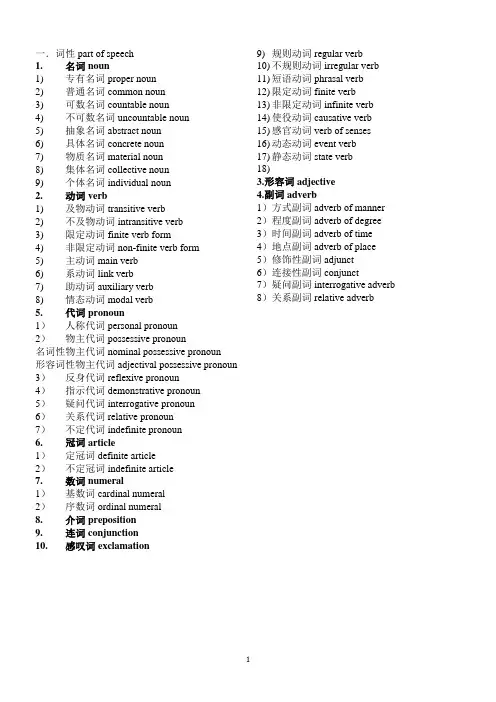
一.词性 part of speech1.名词 noun1)专有名词 proper noun2)普通名词 common noun3)可数名词 countable noun4)不可数名词 uncountable noun5)抽象名词 abstract noun6)具体名词 concrete noun7)物质名词 material noun8)集体名词 collective noun9)个体名词 individual noun2.动词 verb1)及物动词 transitive verb2)不及物动词 intransitive verb3)限定动词 finite verb form4)非限定动词 non-finite verb form5)主动词 main verb6)系动词 link verb7)助动词 auxiliary verb8)情态动词 modal verb 9)规则动词 regular verb10)不规则动词 irregular verb11)短语动词 phrasal verb12)限定动词 finite verb13)非限定动词 infinite verb14)使役动词 causative verb15)感官动词 verb of senses16)动态动词 event verb17)静态动词 state verb18)3.形容词 adjective4.副词 adverb1)方式副词adverb of manner 2)程度副词adverb of degree 3)时间副词adverb of time4)地点副词adverb of place5)修饰性副词 adjunct6)连接性副词 conjunct7)疑问副词 interrogative adverb 8)关系副词 relative adverb5.代词 pronoun1)人称代词 personal pronoun2)物主代词 possessive pronoun名词性物主代词 nominal possessive pronoun形容词性物主代词 adjectival possessive pronoun 3)反身代词 reflexive pronoun4)指示代词 demonstrative pronoun5)疑问代词 interrogative pronoun6)关系代词 relative pronoun7)不定代词 indefinite pronoun6.冠词 article1)定冠词 definite article2)不定冠词 indefinite article7.数词 numeral1)基数词 cardinal numeral2)序数词 ordinal numeral8.介词 preposition9.连词 conjunction10.感叹词 exclamation一、 数/格/性 number/case/gender 1. 数number1) 单数形式 singular form 2) 复数形式 plural form 3) 规则形式 regular form 4) 不规则形式 irregular form 2. 格case1) 普通格 common case 2) 所有格 possessive case 3) 主格 nominative case 4) 宾格 objective case 3. 性gender 1) 阴性 feminine 2) 阳性 masculine 3) 中性 neuter 4) 通性 common 4. 人称 person 第一人称 first person 第二人称 second person 第三人称 third person二、 句子成分 members of sentences 1. 主语 subject 2. 谓语 predicate 3. 表语 predicative 4. 宾语 object1) 双宾语 dual object 2) 直接宾语 direct object 3) 间接宾语 indirect object 4) 复合宾语 complex object 5) 同源宾语 cognate object 5. 定语 attribute 6. 状语 adverbial 7. 同位语 appositive 8. 补语 complement1) 主补subject complement 2) 宾补object complement 9. 表语 predicative 10. 定语 attribute 11. 同位语 appositive 12. 状语 adverbial三、 句子sentence (基本句型 basic sentence patern) 1. 简单句 simple sentence 2. 并列句 compound sentence 3. 复合句 complex sentence 4. 并列复合句 compound complex sentence 5. 陈述句 declarative sentence 6. 存在句 existential sentence 7. 疑问句 interrogative sentence 1) 一般疑问句 general question 2) 特殊疑问句 special question 3) 选择疑问句 alternative question 4) 反义疑问句 disjunctive question 5) 附加疑问句 tag question 6) 反义疑问句 disjunctive question 7) 修辞疑问句 rhetorical question 8) 感叹疑问句 exclamatory question 8. 肯定句 positive sentence 9. 否定句 negative sentence 10. 祈使句 imperative sentence 11. 省略句 elliptical sentence 12. 感叹句 exclamatory sentence 四、 语气/语态/语序 mood/voice/order 1. 语气mood 1) 陈述语气 indicative mood 2) 祈使语气 imperative mood 3) 虚拟语气 subjunctive mood 2. 语态voice 主动语态 active voice 被动语态 passive voice 3. 否定 negation 否定范围 scope of negation 全部否定 full negation 局部否定 partial negation 转移否定 shift of negation 4. 语序 order 1) 自然语序 natural order 2) 倒装语序inversion i. 全部倒装 full inversion ii. 部分倒装 partial inversion 3) 直接引语 direct speech 4) 间接引语 indirect speech 5) 自由直接引语 free direct speech 6) 自由间接引语 free indirect speech 5. 一致 agreement 主谓一致 subject-predicate agreement 语法一致 grammatical agreement 概念一致 notional agreement 就近原则 principle of proximity 强调 emphasis 重复 repetition6. 语音 pronunciation 语调 tone 升调 rising tone 降调 falling tone 降升调 falling-rising tone7. 文体 style 正式文体 formal 非正式文体 informal 、 口语 spoken/oral English 套语 formulistic expression 英国英语 British English 美国英语 American English8. 用法 usage 感情色彩 emotional coloring 褒义 commendatory 贬义 derogatory 幽默 humorous 讽刺 sarcastic 挖苦 ironic 词性 part of speech 语法 grammar 句法 syntax 词法 morphology 结构 structure 层次 rank 句子 sentence 从句 clause 词组 phrase9. 词类 part of speech 单词 word 实词 notional word 虚词 structural word 单纯词simple word 派生词derivative 复合词compound 10. 句法关系 syntatic relationship 并列 coordinate 从属 subordination 修饰 modification 前置修饰 pre-modification 后置修饰 post-modification 限制 restriction 双重限制 double-restriction 非限制 non-restriction 五、 从句clause 1. 从属句 subordinate clause 2. 并列句 coordinate clause 3. 名词性从句 nominal clause 1) 主语从句subject clause 2) 表语从句 predicative clause 3) 宾语从句 object clause 4) 同位语从句appositive clause 4. 定语从句 attributive clause 5. 宾语从句 object clause 6. 主语从句 subject clause 7. 同位语从句 appositive clause 8. 状语从句adverbial clause 1) 时间状语从句 adverbial clause of time 2) 地点状语从句 adverbial clause of place 3) 方式状语从句 adverbial clause of manner 4) 让步状语从句 adverbial clause of concession 5) 原因状语从句 adverbial clause of cause 6) 结果状语从句 adverbial clause of result 7) 目的状语从句 adverbial clause of purpose 8) 条件状语从句 adverbial clause of condition 真实条件状语从句adverbial clause of real condition 非真实条件状语从句 adverbial clause of unreal condition 含蓄条件句 adverbial clause of implied condition错综条件句 adverbial clause of mixed condition 9) 比较状语从句 adverbial clause of comparison 六、 时态 tense 1. 现在时present tense 1) 一般现在时 present simple tense 2) 现在进行时 present continuous tense 3) 现在完成时 present perfect tense 4) 现在完成进行时 present perfect continuous tense 2. 过去时 past tense 1) 一般过去时past simple tense 2) 过去进行时 past continuous tense 3) 过去完成时 past perfect tense 4) 过去完成进行时 past perfect continuous tense 3. 将来时future tense 1) 一般将来时 future simple tense 2) 将来进行时 future continuous tense 3) 将来完成时 future perfect tense 4) 将来完成进行时 future perfect continuous tense 4. 其他 1) 一般过去将来时past future tense2) 过去将来进行时 past future continuous tense 3) 过去将来完成时 past future perfect tense 4) 过去将来完成进行时past future perfectcontinuous tense。
50个常用英语语法结构术语中英文对照1. Noun (名词) - It's like the building blocks of a sentence. For example, “Dog” is a noun. I saw a dog in the park yesterday.2. Verb (动词) - This is the action part. It's the engine that makes the sentence move. Like “run”. She run s ever y morning to keep fit.3. Adjective (形容词) - It's the spice that flavors the noun. For instance, “beautiful”. That beautiful flower caught my eye.4. Adverb (副词) - It modifies the verb, like a sidekick. “Quickly” is an adverb. He ran quickly to catch the bu s.5. Pronoun (代词) - It stands in for a noun. It's like a substitute player. “He” is a pronoun. He is my friend.6. Preposition (介词) - It shows the relationship between things. It's like a bridge. “On” is a preposition. The book is on the table.7. Conjunction (连词) - It connects words or phrases. It's like a glue. “And” is a conjunction. I like apples and bananas.8. Interjection (感叹词) - It shows sudden feelings. It's like an outburst. “Wow!” is an interjection. Wow! What a great view!9. Subject (主语) - It's the star of the sentence. It's like the leadactor. “Tom” is the subject in “Tom is reading a book.”10. Predicate (谓语) - It tells what the subject does. It's like the script for the lead actor. In “Tom is reading a book.”, “is readinga book” is the pre dicate.11. Gerund (动名词) - It's a verb acting like a noun. It's like a shape - shifter. “Swimming” is a gerund. Swimming is good exercise.12. Infinitive (不定式) - It has a “to” before the verb. It's like a goal - setter. “To run” is an infinitive. I want to run a marathon.13. Plural (复数) - More than one. It's like a group. “Cats” is the plural of “cat”. There are many cats in the alley.14. Singular (单数) - Just one. It's like a solo. “Cat” is a singular noun. A cat is sleeping on the mat.15. Tense (时态) - It shows when the action happens. It's like a time - traveler. “I walked” (past tense). I walked to school yesterday.16. Present Simple (一般现在时) - It's for regular things. It's likea daily routine. He plays football every week.17. Past Simple (一般过去时) - For things that already happened.It's like a memory. She visited Paris last year.18. Future Simple (一般将来时) - For things that will happen. It's like a prediction. I will go to the concert tomorrow.19. Present Continuous (现在进行时) - An action that is happening right now. It's like a live show. He is reading a book at the moment.20. Past Continuous (过去进行时) - An action that was happening in the past. It's like a flashback. She was cooking when I arrived.21. Future Continuous (将来进行时) - An action that will be happening in the future. It's like a peek into the future. They will be flying to London this time tomorrow.22. Present Perfect (现在完成时) - Connects the past and the present. It's like a bridge between times. I have eaten breakfast already.23. Past Perfect (过去完成时) - An action that was completed before another past action. It's like a double memory. She had left before I got there.24. Future Perfect (将来完成时) - An action that will becompleted before a certain time in the future. It's like a future - focused memory. By next year, I will have graduated from college.25. Active Voice (主动语态) - The subject does the action. It's like the hero taking the lead. Tom painted the wall.26. Passive Voice (被动语态) - The subject receives the action. It's like the hero being pushed into the background. The wall was painted by Tom.27. Direct Object (直接宾语) - It receives the action of the verb directly. It's like a gift receiver. I gave her a bo ok. “book” is the direct object.28. Indirect Object (间接宾语) - It's like the middleman. In “I gave her a book.”, “her” is the indirect object.29. Clause (从句) - It's like a mini - sentence within a sentence. “When I grow up” is a clause. When I grow up, I w ant to be a doctor.30. Main Clause (主句) - It's the big boss of the sentence. In “When I grow up, I want to be a doctor.”, “I want to be a doctor” is the main clause.31. Subordinate Clause (从属从句) - It depends on the mainclause. It's like a sidekick to the main clause. In the previous example, “When I grow up” is the subordinate clause.32. Relative Clause (关系从句) - It gives more information abouta noun. It's like a detective uncovering details. The man who is wearing a hat is my uncle.33. Definite Article (定冠词) - “The” - It's like a spotlight on a specific thing. The book on the table is mine.34. Indefinite Article (不定冠词) - “A” or “An” - It's like a general pointer. A dog ran across the road.35. Comparative (比较级) - Comparing two things. It's like a race. My car is faster than yours.36. Superlative (最高级) - The top of the comparison. It's like a winner's crown. This is the tallest building in the city.37. Phrase (短语) - A group of words without a subject - predicate. It's like a team without a leader. “in the park” is a phrase.38. Idiom (习语) - A group of words with a special meaning. It's like a secret code. “Break a leg” means good luck.39. Ellipsis (省略) - Leaving out words. It's like skipping steps.“He is taller than I (am)”.40. Parenthesis (插入语) - Extra information in the middle. It's like a side note. My friend, you know, is really smart.41. Capitalization (大写) - Making the first letter big. It's like giving a word a special hat. “London” starts with a capital letter.42. Punctuation (标点符号) - It's like the traffic signs in a sentence. A comma, like “,”, can make a difference in meaning.43. Possessive (所有格) - Showing ownership. It's like a label. “John's book” shows that the book belongs to John.44. Reflexive Pronoun (反身代词) - It refers back to the subject. It's like a self - mirror. He hurt himself while playing.45. Reciprocal Pronoun (相互代词) - For two - way actions. It's like a handshake. They love each other.46. Demonstrative Pronoun (指示代词) - Pointing out things. It's like a finger. This is my house.47. Intensive Pronoun (强调代词) - For emphasis. It's like a loudspeaker. I myself will do it.48. Antecedent (先行词) - The word that a pronoun refers to. It's like a target. In “John lost his book. He was sad.”, “John” is theantecedent of “he”.49. Complement (补语) - Completes the meaning. It's like the missing piece. She is happy (happy is the complement).50. Object Complement (宾语补足语) - Completes the object. It's like the extra topping on a pizza. We made the room clean (clean is the object complement).Learning these English grammar structure terms is really important. They are like the keys to unlock the magic of the English language. If you don't know them, it's like trying to build a house without tools. So, start learning them and have fun with the English language!。
一、词性 part of speech1.名词 noun1)专有名词 proper noun2)可数名词 countable noun3)不可数名词 uncountable noun2.动词 verb1)及物动词 transitive verb2)不及物动词 intransitive verb3)系动词 link verb4)助动词 auxiliary verb5)情态动词 modal verb6)规则动词 regular verb7)不规则动词 irregular verb8)使役动词 causative verb9)感官动词 verb of senses3.形容词 adjective4.副词 adverb1)疑问副词 interrogative adverb2)关系副词 relative adverb5.代词 pronoun1)人称代词 personal pronoun2)物主代词 possessive pronouni.名词性物主代词 nominal possessive pronounii.形容词性物主代词 adjectival possessive pronoun 3)反身代词 reflexive pronoun4)指示代词 demonstrative pronoun5)疑问代词 interrogative pronoun6)关系代词 relative pronoun7)不定代词 indefinite pronoun6.冠词 article1)定冠词 definite article2)不定冠词 indefinite article7.数词 numeral1)基数词 cardinal numeral2)序数词 ordinal numeral8.介词 preposition9.连词 conjunction10.感叹词 exclamation二、数/格/性 number/case/gender1.数number1)单数形式 singular form2)复数形式 plural form2.格case1)所有格 possessive case2)主格 nominative case3)宾格 objective case三、句子成分 members of sentences1.主语 subject2.谓语 predicate3.表语 predicative4.宾语 object1)双宾语 dual object2)直接宾语 direct object3)间接宾语 indirect object4)复合宾语 complex object5.定语 attribute6.状语 adverbial7.同位语 appositive8.补语 complement1)主补(主语补语) subject complement2)宾补(宾语补语) object complement四、句子sentence1.简单句 simple sentence2.复合句 complex sentence3.并列句 compound sentence4.陈述句 declarative sentence5.疑问句 interrogative sentence1)一般疑问句 general question2)特殊疑问句 special question3)选择疑问句 alternative question4)反义疑问句 disjunctive question6.肯定句 positive sentence7.否定句 negative sentence8.祈使句 imperative sentence9.省略句 elliptical sentence10.感叹句 exclamatory sentence五、语气/语态/语序 mood/voice/order1.语气mood1)陈述语气 indicative mood2)祈使语气 imperative mood3)虚拟语气 subjunctive mood2.语态voice1)主动语态 active voice2)被动语态 passive voice3.语序 order1)直接引语 direct speech2)间接引语 indirect speech六、从句clause1.名词性从句 nominal clause1)主语从句subject clause2)表语从句 predicative clause3)宾语从句 object clause2.定语从句 attributive clause3.状语从句adverbial clause1)时间状语从句 adverbial clause of time2)地点状语从句 adverbial clause of place3)方式状语从句 adverbial clause of manner4)让步状语从句 adverbial clause of concession5)原因状语从句 adverbial clause of cause6)结果状语从句 adverbial clause of result7)目的状语从句 adverbial clause of purpose8)条件状语从句 adverbial clause of condition9)比较状语从句 adverbial clause of comparison 七、时态 tense1.现在时present tense1)一般现在时 present simple tense2)现在进行时 present continuous tense3)现在完成时 present perfect tense4)现在完成进行时 present perfect continuous tense 2.过去时 past tense1)一般过去时past simple tense2)过去进行时 past continuous tense3)过去完成时 past perfect tense4)过去完成进行时 past perfect continuous tense3.将来时future tense1)一般将来时 future simple tense2)将来进行时 future continuous tense3)将来完成时 future perfect tense4)将来完成进行时 future perfect continuous tense4.其他1)一般过去将来时past future tense2)过去将来进行时 past future continuous tense3)过去将来完成时 past future perfect tense4)过去将来完成进行时past future perfect continuous tense。
英语语法术语及翻译morphology 词法notional 实词r o t 词根synonym 同义词derivation 派生法compound 复合词pr o no un代词verb 动词preposition 介词particle 引导词common noun 普通名词词material noun 物质名词form word 虚词word-building 构词法prefix 前缀suffix 后缀antonym 反义词conversion 转化法affixation 词缀法c omposition 合成法parts of speech 词类noun 名词numeral 数词adjective 形容词adverb 副词article冠词conjunction 连词interjection 感叹词classification of nouns 名词的分类proper noun 专有名词collective noun 集合名abstract noun 抽象名词countable noun 可数名词personal pronoun 人称代词possessive pronoun 物主代词reflexive pronoun 反身代词interrogative p r o n o un疑问代demonstrative pronoun 指示代词词relative pronoun 关系代词indefinite pronoun 不定代词reciprocal pronoun 相互代词 case 格nominative case 主格objective case 宾格possessive case 所有格singular form 单数形式plural form 复数形式cardinal numeral 基数词ordinal numeral 序数词fraction numeral 分数数词degrees of comparison 比较级positive degree 原级comparative degree 比较级superlative degree 最高级notional verb 实义动词 modal verb 情态动词link verb 连系动词auxiliary verb 助动词transitive verb 及物动词intransitive verb 不及物动词 regular verb 规则动词irregular verb 不规则动词 finite verb 限定动词non-finite verb 非限定动词person 人称number 数gender 性tense 时态voice 语态mood 语气principal forms o f verbs 动词的主要形式present form 现在形式past form 过去形式participle 分词present participle 现在分词past participle 过去分词infinitive 不定式gerund 动名词verbal noun 动名词simple present tense 一般现在时simple past tense 一般过去时simple future tense 一般将来时present continuous tense 现在进行时past continuous tense 过去进行时future continuous tense 将来进行时past perfect tense 过去完成时future perfect tense 将来完成时present perfect continuous tense 现在完成进行时future perfect continuous tense 将来完成进行时sequence of tenses 时态的呼应passive voice 被动语态active voice 主动语态indicative mood 陈述语气imperative mood 祈使语气subjunctive mood 虚拟语气adverb of time 时间副词adverb of place 地点副词adverb of manner 方式副词adverb o f degr e 程度副词adverb of frequency 频度副词conjunctive adverb 连接副词definite article定冠词indefinite article不定冠词coordinating conjunction 并列连词subordinating conjunction 从属连词syntax 句法declarative sentence 陈述句imperative sentence 祈使句exclamatory sentence 感叹句interrogative sentence 疑问句general question 一般疑问句special question 特殊疑问句alternative question 选择疑问句disjunctive question 反意疑问句simple sentence 简单句compound sentence 并列句complex sentence 复合句compound complex sentence并列复合句elliptical sentence省略句elements of the sentence 句子成分subject 主语predicate 谓语predicative 表语attribute 定语adverbial 状语modifier状语appositive 同位语independent element 独立成分limiting attribute 限定性定语descriptive attribute 描绘性定语simple predicate 简单谓语compound predicate 复合谓语direct object 直接宾语indirect object 间接宾语complex object 复合宾语cognate object 同源宾语direct address 呼语parenthesis 插入语appended element 附加成分inserted element 插入成分direct speech 直接引语indirect speech 间接引语absolute construction 独立结构phrase 短语participial phrase 分词短语prepositional phrase 介词短语infinitive phrase 不定式短语verb phrase 动词短语clause 从句main clause 主句subordinate clause 从句subject clause 主语从句object clause 宾语从句predicative clause 表语从句attributive clause 定语从句appositive clause 同位语从句adverbial clause 状语从句restrictive attributive clause 限制性定语从句non-restrictive attributive clause 非限制性定语从句natural word-order 自然语序inverted word-order 倒装语序inversion 倒装ellipsis 省略transformation of sentence 句型的转换 analysis of sentence 句子分析punctuation marks 标点符号period 句号full stop 句号question mark 问号exclamation mark 感叹号comma 逗号semicolon 分号colon 冒号dash 破折号hyphen 连字号quotation marks 引号parenthesis 括号apostrophe 撇号(所有号,重音号,省字号)。
语法术语英汉对照表(总汇)■A・abstract noun 抽象名词active voice 主动态adjective 形容词adjunct 修饰性状语,结合性附加语adverb 副词adverbial 状语adverbial clause of condition 条件状语分句adverbial clause of purpose 目的状语分句adverbial clause of cause 缘故状语分句adverbial clause of result 结果状语分句affix 词缀agreement/concord 一致关系alternative question 选择疑问句anaphoric reference 后照顾antecedent 先行项aspect 体assertive word 确信词auxiliary verb/auxiliary 助动词■B・basic clause pattern 大体句型be- passive be-型被动态be- subjunc tive be-型虚拟式bound morpheme 粘附词素broad reference 广漠照顾■ C・cardinal numeral 基数词cataphoric reference 前照顾central determiner 中位限定词classifier 类别词clausal ellipsis 分句性省略clausal substitution 分句性替代clause 分句,从句cleft sentence 割裂句climax 层进法closed-class word 封锁性词类collective noun 集体名词command 祈使句common gender 通性common noun 一般名词complement 补语complex clause 复杂分句complex object 复杂宾语complex sentence 复杂句compound complexsentence 并列复杂句compound sentence 并列句compound word 复合词coherence 连贯性cohesion 粘着性conditional 条件句conjunct 连接性状语,连接性附加语conjunction 连词content word 实义词contextual meaning上下文意义coordination 并列coreference 共指关系coreference pro-form 指代词countable noun 可数名词count noun 计数名词■D・dangling modifier 无依着修饰语deep structure 深层结构definite article 定冠词definite specific reference 确信特指demonstrative determiner 指示限定词demonstrative pronoun 指示代词demonstrative reference 指示照顾dependent clause 附属分句derivative 派生词descriptive grammar 描述语法determiner 限定词direct object 直接宾语direct speech 直接引语discourse 篇章,语篇disjunct 评注性状语,分离性附加语double negation 双重否定downtoner 弱化词dynamic verb 动态动词■E・earlier time 先时性-ed participle clause -ed 分词分句ellipsis 省略emphasizer 强化词end focus 句尾核心end weight 句尾重心exclamation 感叹句existential sentence 存在句explanatory conditional 讲解性条件句external negation 外部否定■F・fall 降调fall-rise 降升调feminine gender 阴性finite clause 限定分句finite verb 限定动词finite verb phrase 限定动词词组first person 第一人称focal element 核心成份form 形free morpheme 自由词素fronting 前置full sentence 完全句functional word 功能词future in the past 过去以后时刻■G・gender 性general question 一样疑问句generic reference类指genitive case 属格get-passive get- 型被动态given information 已知信息grammar 语法grammatical connector 语法纽带grammatical meaning 语法意义headword 中心词hierarchical structure 层次结构hypothetical meaning 假设意义hypothetical past time 假设性过去时刻hypothetical present time 假设性此刻时刻imaginary present time 想象性此刻时刻implicational conditional 引申性条件句implied conditional 含蓄条件句indefinite article 不定冠词indefinite personal pronoun 不定人称代词indefinite pronoun 不定代词indefinite specific reference 非确信特指independent clause 独立分句indirect object 间接宾语indirect speech 间接引语individual noun 个体名词infinitive clause 不定式分句inflection 屈折转变information focus 信息中心-ing participle clause -ing 分词分句interjection 感叹词internal negation 内部否定interrogative pronoun 疑问代词intransitive verb 不及物动词inversion 倒装■ K・kernel sentence 核心句■L・later time 后时性lexical connector 辞汇纽带lexical meaning 辞汇意义linear structure 线性结构linking verb 连系动词logical connector 逻辑纽带logical necessity 逻辑必然low-rise 低升调■M・main clause 主句main verb 主动词marginal modal auxiliary 边际情态助动词masculine gender 阳性mass noun 不可数名词material noun 物质名词meaning 义minor sentence 不完全句modal auxiliary 情态助动词modification 修饰morpheme 词素morpheme word 单词素词multi-word verb 多词动词■N・negative word 否定词neuter gender 中性new information 新信息nominal ellipsis 名词性省略nominal substitution 名词性替代non-assertive word 非确信词non-finite clause 非限定分句non-finite verb phrase 非限定动词词组non-restrictive modifier 非限制性修饰语noun 名词noun genitive 名词属格noun modifier 名词修饰语noun phrase 名词词组nucleus 调心nucleur pattern 调心型■ 0・object 宾语object complement 宾语补语objective case 宾格obligation 义务of- gen itive of-属格one-member sentence 单成份句open-class word 开放性词类operator 操作词ordinal numeral 序数词■ P・paragraph 段落parallel construction 平行结构passive voice 被动态past perfective 过去完成体past perfective progressive 过去完成进行体past progressive 过去进行体past tense 过去时perfective aspect 完成体permission 许可personal pronoun 人称代词personal reference 人称照顾phonology 语音(语音学、音位学)phrasal-prepositional verb 词组介词动词phrasal verb 词组动词phrase 词组possessive determiner 物主限定词possessive pronoun 物主代词possibility 可能postdeterminer 后位限定词postmodifier 后置修饰语postponement 后置predeterminer 前位限定词predicate 谓语predicate verb 谓语动词predictability 预测prefix 前缀premodifier 前置修饰语preposition 介词prepositional verb 介词动词prescriptive grammar 规定语法present-future time 与此刻时刻有联系的以后时刻present perfective 此刻完成体present perfective progressive 此刻完成进行体present progressive 此刻进行体present tense 此刻时primary auxiliary 大体助动词primary derivative 原始派生词pro-form 替代词progressive aspect 进行体pronoun 代词pronoun reference 代词照顾proper noun 专出名词pseudo-cleft sen tence “ 拟似”割裂句pure future time 单纯以后时刻■Q・question 疑问句■R・real conditional 真实条件句real past time 真实性过去时刻real present time 真实性此刻时刻reference 照顾关系reflexive pronoun 反身代词relative adverb 关系副词relative clause 关系分句relative determiner 关系限定词relative pronoun 关系代词restrictive modifier 限制性修饰语rhetoric 修辞rhetorical question 修辞疑问句■S・same time 同时性second person 第二人称semantics 语义(语义学)semi-auxiliary 半助动词semi-negative word 半否定词sentence 句子sentence group 语段,句群sentence modifier 句子修饰语simple clause 简单分句simple past 一样过去时simple present 一样此刻时simple sentence 简单句situational meaning 情景意义sound 音special question 特殊疑问句specific reference 特指split infinitive 割裂不定式squinting modifier 偏斜修饰语statement 陈述句stative verb 静态动词structural meaning 结构意义structural word 结构词style disjunct 方式评注性状语subject 主语subject complement 主语补语subjective case 主格subordinate clause 从句subordination 从属substitution 替代substitution pro-form 替代词suffix 后缀surface structure 表层结构■ T・tag question 附加疑问句tense 时tense system 时制third person 第三人称time 时刻tone unit 语调组trailing sentence 拖沓句transferred epithet 转移修饰语transitive verb 及物动词■u・uncountable noun 不可数名词unique reference 独指unity 统一性unreal conditional 非真实条件句■v・verb 动词verb phrase 动词词组verbal ellipsis 动词性省略verbal substitution 动词性替代verbless clause 无动词分句volition 意志■ W・were-subjunc tive were-型虚拟式wh- ques tion wh-问句whenever-type cond itio nal whenever-型条件句word 词■ Y・yes-no question 是非问句■z・zero article 零冠词词法morphology句法syntax 句子sentence 从句clause 词组phrase 词类part of speech 实词notional word 虚词structural word 单纯词simple word 派生词derivative 复合词compound 词性part of speech 名词noun 专出名词proper noun 一般名词common noun 可数名词countable noun 不可数名词uncountable noun 抽象名词abstract noun 具体名词concrete noun 物质名词material noun 集体名词collective noun 个体名词individual noun 介词preposition 连词conjunction 动词verb 主动词main verb及物动词transitive verb 不及物动词intransitive verb 系动词link verb 助动词auxiliary verb 情态动词modal verb 规那么动词regular verb 不规那么动词irregular verb 短语动词phrasal verb 限定动词finite verb 非限定动词infinite verb 使役动词causative verb 感官动词verb of senses 动态动词event verb 静态动词state verb感叹词exclamation 形容词adjective 原级positive 比较级comparative 最高级superalative 副词adverb 方式副词adverb of manner 程度副词adverb of degree 时刻副词adverb of time 地址副词adverb of place 修饰性副词adjunct 连接性副词conjunct 疑问副词interrogative adverb 关系副词relative adverb 代词pronoun 人称代词personal pronoun物主代词possessive pronoun反身代词reflexive pronoun彼此代词reciprocal pronoun指示代词demonstrative pronoun疑问代词interrogative pronoun关系代词relative pronoun不定代词indefinite pronoun物主代词possessive pronoun名词性物主代词nominal possessive pronoun形容词性物主代词adjectival possessive pronoun冠词article定冠词definite article不定冠词indefinite article数词numeral基数词cardinal numeral序数词ordinal numeral分数词fractional numeral形式form单数形式singular form复数形式plural form限定动词finite verb form非限定动词non-finite verb form原形base form英语经常使用语法术语230条句子sentence从句clause词组phrase词类part of speech单词word实词notional word 虚词structural word 单纯词simple word 派生词derivative 复合词compound 词性part of speech 名词noun 专出名词proper noun 一般名词common noun 可数名词countable noun 不可数名词uncountable noun 抽象名词abstract noun 具体名词concrete noun 物质名词material noun 集体名词collective noun 个体名词individual noun 介词preposition 连词conjunction 动词verb 主动词main verb 及物动词transitive verb 不及物动词intransitive verb 系动词link verb 助动词auxiliary verb 情态动词modal verb 规那么动词regular verb 不规那么动词irregular verb 短语动词phrasal verb 限定动词finite verb非限定动词infinite verb使役动词causative verb感官动词verb of senses动态动词event verb静态动词state verb感叹词exclamation形容词adjective副词adverb方式副词adverb of manner程度副词adverb of degree时刻副词adverb of time地址副词adverb of place修饰性副词adjunct连接性副词conjunct疑问副词interrogative adverb关系副词relative adverb代词pronoun人称代词personal pronoun物主代词possessive pronoun反身代词reflexive pronoun彼此代词reciprocal pronoun指示代词demonstrative pronoun疑问代词interrogative pronoun关系代词relative pronoun不定代词indefinite pronoun物主代词possessive pronoun名词性物主代词nominal possessive pronoun 形容词性物主代词adjectival possessive pronoun 冠词article定冠词definite article不定冠词 indefinite article 数词 numeral基数词 cardinal numeral序数词 ordinal numeral分数词 fractional numeral形式 form单数形式 singular form复数形式 plural form限定动词 finite verb form 非限定动词 non-finite verb form 原形 base form 从句 clause从属句 subordinate clause并列句 coordinate clause名词从句 nominal clause定语从句 attributive clause状语从句 adverbial clause宾语从句 object clause主语从句 subject clause同位语从句 appositive clause time place manner concession cause result purpose condition 真实条件状语从句 adverbial clause of real condition 非真实条件状语从句 adverbial clause of unreal condition adverbialclause of adverbialclause of adverbialclause of adverbialclause of adverbialclause of adverbialclause of adverbialclause of adverbial clause of 时刻状语从句 地址状语从句 方式状语从句 妥协状语从句 缘故状语从句 结果状语从句 目的状语从句 条件状语从句含蓄条件句adverbial clause of implied condition 错综条件句adverbial clause of mixed condition 简单句simple sentence 并列句compoundsentence 复合句complex sentence并列复合句compound complex sentence 陈述句declarative sentence 疑问句interrogative sentence一样疑问句general question 特殊疑问句special question选择疑问句alternative question 附加疑问句tag question反义疑问句disjunctive question 修辞疑问句rhetorical question 感叹疑问句exclamatory question 存在句existential sentence 确信句positive sentence 大体句型basic sentence pattern 否定句negative sentence 祈使句imperative sentence 省略句elliptical sentence 感叹句exclamatory sentence 句子成份members of sentences 主语subject 谓语predicate 宾语object 双宾语dual object 直接宾语direct object 间接宾语indirect object 复合宾语complex object同源宾语cognate object补语complement主补subject complement宾补object complement表语predicative定语attribute同位语appositive状语adverbial句法关系syntactic relationship并列coordinate从属subordination修饰modification前置修饰pre-modification后置修饰post-modification限制restriction双重限制double-restriction非限制non-restriction数number单数形式singular form复数形式plural form规那么形式regular form 不规那么形式irregular form 格case一般格common case所有格possessive case主格nominative case宾格objective case性gender阳性masculine阴性feminine通性common 中性neuter 人称person 第一人称first person 第二人称second person 第三人称third person 时态tense 过去以后时past future tense 过去以后进行时past future continuous tense 过去以后完成时past future perfect tense 一样此刻时present simple tense 一样过去时past simple tense 一样以后时future simple tense 此刻完成时past perfect tense 过去完成时present perfect tense 以后完成时future perfect tense 此刻进行时present continuous tense 过去进行时past continuous tense 以后进行时future continuous tense 过去以后进行时past future continuous tense 此刻完成进行时present perfect continuous tense 过去完成进行时past perfect continuous tense 语态voice 主动语态active voice 被动语态passive voice 语气mood 陈述语气indicative mood 祈使语气imperative mood 虚拟语气subjunctive mood 否定negation否定范围scope of negation 全数否定full negation 局部否定partial negation 转移否定shift of negation 语序order自然语序natural order 倒装语序inversion 全数倒装full inversion 部份倒装partial inversion 直接引语direct speech 间接引语indirect speech 自由直接引语free direct speech 自由间接引语free indirectspeech 一致agreement主谓一致subject-predicate agreement 语法一致grammaticalagreement 概念一致notional agreement 就近原那么principle of proximity 强调emphasis 重复repetition 语音pronunciation 语调tone 升调rising tone 降调falling tone 降升调falling-rising tone 文体style 正式文体formal 非正式文体informal 口语spoken/oral English 套语formulistic expression英国英语British English美国英语American English用法usage情感色彩emotional coloring幽默humorous褒义commendatory贬义derogatory挖苦sarcastic挖苦ironic语法grammar句法syntax词法morphology结构structure层次rank。
英语语法术语(中英文对照)1、 词性 part of speech1. 名词 noun1) 专有名词 proper noun2) 普通名词 common noun3) 可数名词 countable noun4) 不可数名词 uncountable noun5) 抽象名词 abstract noun6) 具体名词 concrete noun7) 物质名词 material noun8) 集体名词 collective noun9) 个体名词 individual noun2. 动词 verb1) 及物动词 transitive verb (Vt)2) 不及物动词 intransitive verb (Vi)3) 系动词 link verb4) 助动词 auxiliary verb5) 情态动词 modal verb6) 规则动词 regular verb7) 不规则动词 irregular verb8) 短语动词 phrasal verb9) 限定动词 finite verb10) 非限定动词 infinite verb11) 使役动词 causative verb12) 感官动词 verb of senses3. 形容词 adjective4. 副词 adverb1)方式副词adverb of manner2)程度副词adverb of degree3)时间副词adverb of time4)地点副词adverb of place5)修饰性副词 adjunct6)连接性副词 conjunct7)疑问副词 interrogative adverb8)关系副词 relative adverb5. 代词 pronoun1)人称代词 personal pronoun2)物主代词 possessive pronouni. 名词性物主代词 nominal possessive pronounii. 形容词性物主代词 adjectival possessive pronoun 3)反身代词 reflexive pronoun4)指示代词 demonstrative pronoun5)疑问代词 interrogative pronoun6)关系代词 relative pronoun7)不定代词 indefinite pronoun6. 冠词 article1)定冠词 definite article2)不定冠词 indefinite article7. 数词 numeral1)基数词 cardinal numeral2)序数词 ordinal numeral8. 介词 preposition9. 连词 conjunction10. 感叹词 exclamation2、 数/格/性 number/case/gender1. 数number1)单数形式 singular form2)复数形式 plural form3)规则形式 regular form4)不规则形式 irregular form2. 格case1)普通格 common case2)所有格 possessive case3)主格 nominative case4)宾格 objective case3、 句子成分 members of sentences1. 主语 subject2. 谓语 predicate3. 表语 predicative4. 宾语 object1)双宾语 dual object2)直接宾语 direct object3)间接宾语 indirect object5. 定语 attribute6. 状语 adverbial7. 同位语 appositive8. 补语 complement1)主补(主语补语) subject complement2)宾补(宾语补语) object complement4、 句子sentence1. 简单句 simple sentence2. 复合句 complex sentence3. 并列句 compound sentence4. 陈述句 declarative sentence5. 存在句 existential sentence6. 疑问句 interrogative sentence1)一般疑问句 general question2)特殊疑问句 special question3)选择疑问句 alternative question4)反义疑问句 disjunctive question7. 肯定句 positive sentence8. 否定句 negative sentence9. 祈使句 imperative sentence10. 省略句 elliptical sentence11. 感叹句 exclamatory sentence5、 语气/语态/语序/一致mood/voice/order/agreement 1. 语气mood1)陈述语气 indicative mood2)祈使语气 imperative mood3)虚拟语气 subjunctive mood2. 语态voice1)主动语态 active voice2)被动语态 passive voice3. 语序 order1)自然语序 natural order2)倒装语序inversioni. 全部倒装 full inversionii. 部分倒装 partial inversion3)直接引语 direct speech4)间接引语 indirect speech4. 一致agreement主谓一致 subject-predicate agreement语法一致 grammatical agreement概念一致 notional agreement就近原则 principle of proximity6、 从句clause1. 名词性从句 nominal clause1) 主语从句subject clause2)表语从句 predicative clause3)宾语从句 object clause4)同位语从句appositive clause2. 定语从句 attributive clause3. 状语从句adverbial clause1)时间状语从句 adverbial clause of time2)地点状语从句 adverbial clause of place3)方式状语从句 adverbial clause of manner4)让步状语从句 adverbial clause of concession5)原因状语从句 adverbial clause of cause6)结果状语从句 adverbial clause of result7)目的状语从句 adverbial clause of purpose8)条件状语从句 adverbial clause of conditioni. 真实条件状语从句adverbial clause of real conditionii. 非真实条件状语从句 adverbial clause of unrealcondition9)比较状语从句 adverbial clause of comparison4. 独立主格结构Nominative Absolute Construction7、 时态 tense1. 现在时present tense1)一般现在时 present simple tense2)现在进行时 present continuous tense3)现在完成时 present perfect tense4)现在完成进行时 present perfect continuous tense2. 过去时 past tense1)一般过去时past simple tense2)过去进行时 past continuous tense3)过去完成时 past perfect tense4)过去完成进行时 past perfect continuous tense3. 将来时future tense1)一般将来时 future simple tense2)将来进行时 future continuous tense3)将来完成时 future perfect tense4)将来完成进行时 future perfect continuous tense4. 其他1)一般过去将来时past future tense2)过去将来进行时 past future continuous tense3)过去将来完成时 past future perfect tense4)过去将来完成进行时past future perfect continuous tense。
词性part of speech1.名词noun1)专有名词proper noun2)普通名词common noun3)可数名词countable noun4)不可数名词uncountable noun5)抽象名词abstract noun6)具体名词concrete noun7)物质名词material noun8)集体名词collective noun9)个体名词individual noun2.动词verb1)及物动词transitive verb2)不及物动词intransitive verb3)限定动词finite verb form4)非限定动词non-finite verb form5)主动词main verb6)系动词link verb7)助动词auxiliary verb8)情态动词modal verb9)规则动词regular verb10)不规则动词irregular verb11)短语动词phrasal verb12)限定动词finite verb13)非限定动词infinite verb14)使役动词causative verb15)感官动词verb of senses16)动态动词event verb17)静态动词stage verb3.形容词adjective4.副词adverb1)方式副词adverb of manner2)程度副词adverb of degree3)时间副词adverb of time4)地点副词adverb of place5)修饰性副词adjunct6)连接性副词conjunct7)疑问副词interrogative adverb8)关系副词relative adverb5.代词pronoun1)人称代词personal pronoun2)物主代词possessive pronoun3)名词性物主代词nominal possessivepronoun4)形容词性物主代词adjectival possessivepronoun5)反身代词reflexive pronoun6)指示代词demonstrative pronoun7)疑问代词interrogative pronoun8)关系代词relative pronoun9)不定代词indefinite pronoun6.冠词article1)定冠词definite article2)不定冠词indefinite article7.数词numeral1)基数词cardinal numeral2)序数词ordinal numeral8.介词preposition9.连词conjunction10.感叹词exclamation一、数/格/性number/case/gender1.数number1)单数形式singular form2)复数形式plural form3)规则形式regular form4)不规则形式irregular form 2.格case1)普通格common case2)所有格possessive case3)主格nominative case4)宾格objective case 3.性gender1)阴性feminine2)阳性masculine3)中性neuter4)通性common4.人称person1)第一人称first person2)第二人称second person3)第三人称third person二、句子成分members of sentences1.主语subject2.谓语predicate3.表语predicative4.宾语object1)双宾语dual object2)直接宾语direct object3)间接宾语indirect object4)复合宾语complex object5)同源宾语cognate object 5.定语attribute6.状语adverbial7.同位语appositive8.补语complement1)主语补足语subject complement2)宾语补足语object complement三、句子sentence (基本句型basic sentence pattern)1.简单句simple sentence2.并列句compound sentence3.复合句complex sentence4.并列复合句compound complexsentence5.陈述句declarative sentence6.存在句existential sentence7.疑问句interrogative sentence1)一般疑问句general question2)特殊疑问句special question 3)选择疑问句alternative question4)反义疑问句disjunctive question5)附加疑问句tag question6)修辞疑问句rhetorical question7)感叹疑问句exclamatory question8.肯定句positive sentence9.否定句negative sentence10.祈使句imperative sentence11.省略句elliptical sentence12.感叹句exclamatory sentence四、语气/语态/语序mood/voice/order1.语气mood1)陈述语气indicative mood2)祈使语气imperative mood3)虚拟语气subjunctive mood2.语态voice1)主动语态active voice2)被动语态passive voice3.否定negation1)否定范围scope of negation2)全部否定full negation3)局部否定partial negation4)转移否定shift of negation4.语序order1)自然语序natural order2)倒装语序inversioni.全部倒装full inversionii.部分倒装partial inversion3)直接引语direct speech4)间接引语indirect speech5)自由直接引语free direct speech6)自由间接引语free indirect speech 5.一致agreement1)主谓一致subject-predicate agreement 2)语法一致grammatical agreement3)概念一致notional agreement4)就近原则principle of proximity5)强调emphasis6)重复repetition6.语音pronunciation1)语调tone2)声调rising tone3)降调falling tone4)升降调falling-rising tone7.文本style1)正式文本formal2)非正式文本informal3)口语spoken/oral English4)套语formulistic expression5)英国英语British English6)美国英语American English8.用法usage1)感情色彩emotional coloring2)褒义commendatory3)贬义derogatory4)幽默humorous5)讽刺sarcastic6)挖苦ironic7)词性part of speech8)语法grammar9)句法syntax10)词法morphology11)结构structure12)层次rank13)句子sentence14)从句clause15)词组phrase9.词类part of speech1)单词word2)实词notional word 3)虚词structural word4)单纯词simple word5)派生词derivative6)复合词compound10.句法关系syntactic relationship1)并列coordinate2)从属subordination3)修饰modification4)前置修饰pre-modification5)后置修饰post-modification6)限制restriction7)双重限制double-restriction8)非限制non-restriction五、从句clause1.从属句subordinate clause2.并列句coordinate clause3.名词性从句nominal clause1)主语从句subject clause2)表语从句predicative clause3)宾语从句object clause4)同位语从句appositive clause4.定语从句attributive clause5.宾语从句object clause6.主语从句subject clause7.同位语从句appositive clause8.状语从句adverbial clause1)时间状语从句adverbial clause of time2)地点状语从句adverbial clause of place3)方式状语从句adverbial clause ofmanner4)让步状语从句adverbial clause ofconcession5)原因状语从句adverbial clause of cause6)结果状语从句adverbial clause of result7)目的状语从句adverbial clause ofpurpose8)条件状语从句adverbial clause ofconditioni.真实条件状语从句adverbialclause of real conditionii.非真实条件状语从句adverbialclause of unreal conditioniii.含蓄条件句adverbial clause ofimplied conditioniv.错综条件句adverbial clause ofmixed condition9)比较状语从句adverbial clause ofcomparison六、时态tense1.现在时present tense1)一般现在时present simple tense2)现在进行时present continuous tense3)现在完成时present perfect tense4)现在完成进行时present perfectcontinuous tense2.过去时past tense1)一般过去时past simple tense2)过去进行时past continuous tense3)过去完成时past perfect tense 4)过去完成进行时past perfect continuoustense3.将来时future tense1)一般将来时future simple tense2)将来进行时future continuous tense3)将来完成时future perfect tense4)将来完成进行时future perfectcontinuous tense4.其他1)一般过去将来时past future tense2)过去将来进行时past future continuoustense3)过去将来完成时past future perfecttense4)过去将来完成进行时past future perfectcontinuous tense。
语法术语中英文1. Noun (名词)countable uncountable (可数名词、不可数名词)Number of N (名词的数)Irregular plurals (不规则复数)Genitive case of N (名词的所有格)Double genitive (双重所有格)2. Pronoun (代词)Personal pronoun (人称代词)Possessive pronoun (物主代词)Reflexive pronoun (反身代词)Interrogative pronoun (疑问代词)Indefinite pronoun (不定代词)3. Numeral (数次)Cardinal 、ordinal numbers (基数词、序数词)Percentage (百分数)Fraction (分数)Decimal (小数)Multiple (倍数)4. Determiner (限定词)Definite, indefinite, zero articles (定冠词,不定冠词,零冠词)Quantifiers (数量词)5. Preposition (介词)6. Adjective (形容词)Attributive 定语Predicative 表语Adverb clause equivalent 副词性从句7. Adverb (副词)Modifier of Adj / Adv / Prep-phrase / N-Phrase / Adverb-clause (形容词、副词、介词短语、副词性从句的修饰语)The comparative and superlative degrees of Adj / Adv (形容词和副词的比较级和最高级)9. Verb classes (动词)Notional verbs(实义动词)Transitive and intransitive verbs (及物动词和不及物动词)Auxiliaries and modal auxiliaries (助动词和情态动词)Semi-auxiliaries (半助动词)Phrasal verbs (短语动词)10. Tense (时态)Simple present, past, future and with modals (一般现在时,一般过去时,一般将来时和情态助动词加动词)Present and past progressive (现在进行时和过去进行时)Future progressive and with modals (将来进行时和情态动词加进行时)Present and past perfect (现在完成时和过去完成时)Future perfect and with modals (将来完成时和情态动词加完成时)Present perfect progressive (现在完成进行时)Past perfect progressive (过去完成进行时)11.Passive voice (被动语态)Passive voice in simple tense (被动语态的一般时态)Passive voice in perfect and progressive tenses (被动语态的完成和进行时态)Passive voice of phrasal verbs (短语动词的被动语态)12. Subjunctive mood (虚拟语气)13. To V (Infinitive 动词不定式)as subject, object and complement (用作主语,宾语和补足语)Indicating purpose / result (表示目的和结果)Modifying adjective (修饰形容词)as post modifier in a noun phrase (后位修饰名词)to be + V-ed2, to have + V-ed2, to be + V-ing (不定式的被动式,完成式和进行式)14. V-ing (Gerund 动名词)object, subject and predicative(宾语,主语和表语)N / Pronouns or their possessive + V-ing as subject and object(名词/ 代词或其所有格加动名词作主语和宾语)Prep + N / Pronouns or their possessive + V-ing(介词加名词/ 代词或其所有格加动名词)being + V-ed2, having + V-ed2, having been + V-ed2 as a noun equivalent(动名词的被动式,完成式和完成被动式起名词作用)15pre-modifier and post modifier in a noun phrase 现在分词和过去分词)as complement (补足语)as an adverb clause equivalent(作状语)When / while, etc. + V-ing / V-ed2 (When / While 等加现在分词或过去分词)(with) N + V-ing / V-ed2 ( [ with ] 名词加现在分词或过去分词)Dangling V-ing as adverb clause equivalent(无归属现在分词作状语)being + V-ed2, having + V-ed2, having been + V-ed2 as an adverb or adjective clause equivalent(现在分词的被动式、完成式和完成被动式作状语或定语)16. Basic sentence patterns and sentence elements(基本句型和句子成份)Pattern 1: S + VPattern 2: S + V + CsPattern 3: S + V + OPattern 4: S + V + Oi + OdPattern 5: S + V + Od + Co17.Interrogative form(疑问形式)Negative form(否定形式)Passive form(被动形式)relative clause(定语从句)Restrictive and non-restrictive(限制性和非限制性定语从句)Appositive clause(同位语从句)Noun phrase appositive to clause(名词短语作句子的同位语)Clause of time and space(时间从句和地点从句)Clauses of condition, concession and contrast(条件从句、让步从句和对比从句)Clauses of cause, result and purpose(原因从句、结果从句和目的从句)Clauses of manner and comparison(方式从句和比较从句)Clauses of proportion and other types(比例从句和其它从句)3rd person pronouns, and plurals of the 1st and 2nd person pronouns(第三人称代词,第一、二人称代词的复数)indefinite pronouns(不定代词)( + of + N / Pron)Subject-verb inversion(主语与谓语倒装)Parenthesis(插入语)Omission(省略)Omission through coordination (并列结构中的省略)Negation (否定)Total negation(全部否定)Partial negation (部分否定)Double negation (双重否定)Transferred negation (转移否定)《朗文高级英语语法》第一章动词时态概述(Overview Of Verb Tenses)1-1 一般时态(The Simple Tenses)1-2 进行时态(The Progressive Tenses)31-3 完成时态(The Perfect Tenses)1-4 完成进行时态(The Perfect Progressive Tenses)1-5 时态用法总结(Summary Chart of Verb Tenses)1-6 -ing 和-ed形式的拼写(Spelling of -ing and -ed Forms)第二章一般现在时,一般过去时,现在进行时和过去进行时(Present And Past, Simple And Progressive)2-1 一般现在时(Simple Present)2-2 现在进行时(Present Progressive)2-3 静态动词( Stative Verbs)2-4 am/is/are being+形容词(am/is/are being + Adjective)2-5 规则动词和不规则动词(Regular and Irregular V erbs)2-6 规则动词:-ed的发音(Regular Verbs: Pronunciation of -ed Endings)2-7 不规则动词表(Irregular Verbs: an Alphabetical List)2-8 易混淆的动词:raise/rise, set/sit, lay/lie (Troublesome Verbs: raise/rise, set/sit, lay/lie)2-9 一般过去时(Simple Past)2-10 过去进行时(Past Progressive)2-11 进行时态与always连用表示抱怨(Using Progressive Verbs with always to Complain)2-12 进行时态中地点状语的用法(Using Expressions of Place with Progressive Verbs)第三章完成时和完成进行时(Perfect And Perfect Progressive Tenses)3-1 现在完成时(Present Perfect)3-2 现在完成进行时(Present Perfect Progressive)3-3 过去完成时(Past Perfect)3-4 过去完成进行时(Past Perfect Progressive)第四章将来时(Future Time)4-1 一般将来时:will 和be going to (Simple Future: will and be going to)4-2 will与be going to的比较(will vs. be going to)4-3 用时间状语从句表示将来(Expressing the Future in Time Clauses)4-4 用一般现在时和现在进行时表示将来(Using the Present Progressive and the Simple Present to Express Future Time)4-5 将来进行时(Future Progressive)4-6 将来完成时(Future Perfect)4-7 将来完成进行时(Future Perfect Progressive)第五章时间状语从句和时态的复习(Adverb Clauses Of Time And Review Of Verb Tenses)5-1 时间状语从句:形式(Adverb Clauses of Time: Form)5-2 用时间状语从句表示时间关系(Using Adverb Clauses to Show Time Relationships)第六章主谓一致(Subject-verb Agreement)6-1 以-s或-es结尾的词:用法、发音和拼写(Final -s/-es: Use, Pronunciation, and Spelling)6-2 基本的主谓一致问题(Basic Subject-verb Agreement)6-3 主谓一致:表达数量(Subject-verb Agreement: Using Expressions of Quantity)6-4 主谓一致:there be的用法(Subject-verb Agreement: Using there + be)6-5 主谓一致:不规则用法(Subject-verb Agreement: Some Irregularities)第七章名词(Nouns)7-1 名词复数形式的规则和不规则变化(Regular and Irregular Plural Nouns)7-2 所有格(Possessive Nouns)1037-3 名词作修饰语(Using Nouns as Modifiers)7-4 可数名词和不可数名词(Count and Noncount Nouns)7-5 不可数名词(Noncount Nouns)7-6 常见不可数名词(Some Common Noncount Nouns)7-7 冠词的基本用法(Basic Article Usage)7-8 冠词用法的基本原则(General Guidelines for Article Usage)7-9数量的表达(Expressions of Quantity)7-10 a few和few,a little和little的用法(Using a few and few; a little and little)7-11 带of 的数量表达(Using of in Expressions of Quantity)7-12 all (of) 和both (of)〔All (of) and both (of)7-13 单数的数量表达:one, each, every (Singular Expressions of Quantity: one, each, every)第八章代词(Pronouns)8-1 人称代词(Personal Pronouns)8-2 人称代词:与类属名词、不定代词的一致性(Personal Pronouns: Agreement with Generic Nouns and Indefinite Pronouns)8-3 人称代词:与集合名词的一致性(Personal Pronouns: Agreement with Collective Nouns) 8-4 反身代词(Reflexive Pronouns)8-5 you, one和they用作非人称代词(Using you, one, and they as Impersonal Pronouns)8-6 other的形式(Forms of other)8-7 other的常见表达(Common Expressions with other)第九章情态动词(一)(Modals, Part 1)9-1 概述(Introduction)9-2 I作主语的礼貌请求(Polite Questions with I as the Subject)9-3 you作主语的礼貌请求(Polite Questions with you as the Subject)9-4 would you mind用作礼貌请求(Polite Requests with would you mind)9-5 表示必须:must, have to, have got to (Expressing Necessity: must, have to, have got to)9-6 不必要和禁止:have to和must的否定形式(Lack of Necessity and Prohibition: have to and must in the Negative)9-7 忠告:should, ought to, had better (Advisability: should, ought to, had better)9-8 should的过去式(The Past Form of should)9-9 期望:be supposed to (Expectations: be supposed to)9-10 提议:let’s, why don’t, shall I/we (Making Suggestions: let’s, why don’t, shall I/we)9-11 提议:could与should的比较(Making Suggestions: could vs. should)第十章情态动词(二)(Modals, Part 2)10-1 表示确定程度:现在时(Degrees of Certainty: Present Time)10-2 表示确定程度:现在时的否定形式(Degrees of Certainty: Present Time Negative)10-3 表示确定程度:过去时(Degrees of Certainty: Past Time)10-4 表示确定程度:将来时(Degrees of Certainty: Future Time)10-5 情态动词的进行式(Progressive Forms of Modals)10-6 表示能力:can和could (Ability: can and could)10-7 would表示过去重复性的动作(Using would to Express a Repeated Action in the Past)10-8 表示倾向:would rather (Expressing Preference: would rather)10-9 情态动词和短语情态动词的结合(Combining Modals with Phrasal Modals)10-10 情态动词和类似表达的总结表(Summary Chart of Modals and Similar Expressions)第十一章被动语态(The Passive)11-1 被动语态的构成(Forming the Passive)11-2 被动语态的用法(Using the Passive)11-3 间接宾语用作被动语态的主语(Indirect Objects Used as Passive Subjects)11-4 情态动词与短语情态动词的被动语态(The Passive Form of Modals and Phrasal Modals)11-5 静态被动语态(Stative Passive)11-6 常见静态被动语态动词+ 介词(Common Stative Passive Verbs + Prepositions)11-7 get与被动语态(The Passive with get)11-8 分词形容词(Participial Adjectives)第十二章名词性从句(Noun Clauses)12-1 概述(Introduction)12-2以疑问词开头的名词性从句(Noun Clauses Beginning with a Question Word)12-3 以whether或if开头的名词性从句(Noun Clauses Beginning with whether or if)12-4 疑问词后接不定式(Question Words Followed by Infinitives)12-5 以that开头的名词性从句(Noun Clauses Beginning with that)12-6 直接引语(Quoted Speech)12-7 间接引语:名词性从句中动词的形式(Reported Speech: Verb Forms in Noun Clauses)12-8 名词性从句中虚拟语气的用法(Using the Subjunctive in Noun Clauses)12-9 带有-ever的词汇的用法(Using -ever Words)第十三章定语从句(Adjective Clauses)13-1 概述(Introduction)13-2 定语从句的关系代词作主语(Adjective Clause Pronouns Used as the Subject)13-3定语从句的关系代词作动词的宾语(Adjective Clause Pronouns Used as the Object of a Verb)13-4 定语从句的关系代词作介词的宾语(Adjective Clause Pronouns Used as the Object of a Preposition)13-5定语从句的常用句型(Usual Patterns of Adjective Clauses)13-6 whose的用法(Using whose)13-7 定语从句中where的用法(Using where in Adjective Clauses)13-8 定语从句中when的用法(Using when in Adjective Clauses)13-9 定语从句修饰代词的用法(Using Adjective Clauses to Modify Pronouns)13-10 定语从句中标点符号的使用(Punctuating Adjective Clauses)13-11 定语从句中数量的表示方法(Using Expressions of Quantity in Adjective Clauses)13-12 名词+of which 的用法(Using Noun + of which)28613-13 which修饰整个句子的用法(Using which to Modify a Whole Sentence)28613-14 将定语从句简化为形容词短语:概述(Reducing Adjective Clauses to Adjective Phrases: Introduction)13-15 将定语从句转变为形容词短语(Changing an Adjective Clause to an Adjective Phrase)第十四章动名词和不定式(一)(Gerunds And Infinitives, Part 1)14-1 动名词:概述(Gerunds: Introduction)14-2 动名词作介词的宾语(Using Gerunds as the Objects of Prepositions)14-3 后面接动名词的常见介词短语(Common Preposition Combinations Followed by Gerunds)14-4 后面接动名词的常见动词(Common Verbs Followed by Gerunds)14-5 go+动名词(go + Gerund)14-6 后面接动词-ing形式的固定搭配(Special Expressions Followed by -ing)14-7 后面接不定式的常见动词(Common Verbs Followed by Infinitives)14-8 后面既可接不定式又可接动名词的常见动词(Common Verbs Followed by either Infinitives or Gerunds)14-9 后面接动名词的动词列表(Reference List of Verbs Followed by Gerunds)14-10 后面接不定式的动词列表(Reference List of Verbs Followed by Infinitives)14-11 it +不定式;动名词和不定式作主语(it + Infinitive; Gerunds and Infinitives as Subjects)第十五章动名词和不定式(二)(Gerunds And Infinitives, Part 2)15-1 表示目的的不定式:in order to (Infinitive of Purpose: in order to)15-2 后面接不定式的形容词(Adjectives Followed by Infinitives)15-3 不定式与too和enough连用(Using Infinitives with too and enough)15-4 不定式和动名词的被动语态和完成式(Passive and Past Forms of Infinitives and Gerunds)15-5 need后接动名词或不定式的被动语态形式(Using Gerunds or Passive Infinitives Following need)15-6 所有格修饰动名词(Using a Possessive to Modify a Gerund)15-7 感官动词的用法(Using Verbs of Perception)15-8 let和help后接动词原形(Using the Simple Form after let and help)15-9 使役动词的用法:make, have, get (Using Causative Verbs: make, have, get)第十六章并列连词(Coordinating Conjunctions)16-1 平行结构(Parallel Structure)16-2 成对连词:both…and; not only…but also; either…or; neither…nor (Using Paired Conjunctions: both . . . and; not only . . . but also; either . . . or; neither . . . nor)16-3 用并列连词连接独立分句(Combining Independent Clauses with Coordinating Conjunctions)第十七章状语从句(Adverb Clauses)17-1 概述(Introduction)17-2 原因状语从句(Using Adverb Clauses to Show Cause and Effect)17-3 表达对比(意外的结果):even though的用法〔Expressing Contrast (Unexpected Result): Using even though〕17-4 表达直接对比:while和whereas (Showing Direct Contrast: while and whereas)17-5 条件状语从句:if从句(Expressing Conditions in Adverb Clauses: if-clauses)17-6 条件状语从句:whether or not 和even if 的用法(Adverb Clauses of Condition: Using whether or not and even if)17-7 条件状语从句:in case 和in the event that的用法(Adverb Clauses of Condition: Using in case and in the event that)17-8 条件状语从句:unless的用法(Adverb Clauses of Condition: Using unless)17-9 条件状语从句:only if的用法(Adverb Clauses of Condition: Using only if)第十八章将状语从句简化为修饰性的副词短语(Reduction Of Adverb Clauses To Modifying Adverbial Phrases)18-1 概述(Introduction)18-2 将时间状语从句简化为修饰性的副词短语(Changing Time Clauses to Modifying Adverbial Phrases)18-3 用修饰性的副词短语表达“与此同时”的概念(Expressing the Idea of “During the Same Time”in Modifying Adverbial Phrases)18-4 用修饰性的副词短语表示因果关系(Expressing Cause and Effect in Modifying Adverbial Phrases)18-5 在修饰性的副词短语中使用“upon + -ing”(Using upon + -ing in Modifying Adverbial Phrases)第十九章表示因果、对比和条件关系的关联词(Connectives That Express Cause And Effect, Contrast, And Condition)19-1 because of 和due to的用法(Using because of and due to)19-2用过渡词表示因果关系:therefore和consequently (Using Transitions to Show Cause and Effect: therefore and consequently)19-3 句型和标点符号小结(Summary of Patterns and Punctuation)19-4 其它表示因果关系的方式:such…that和so…that (Other Ways of Expressing Cause and Effect: such . . . that and so . . . that)19-5表示目的:so that的用法(Expressing Purpose: Using so that)19-6表示对比(意料之外的结果)〔Showing Contrast (Unexpected Result)〕19-7表示直接对比(Showing Direct Contrast)19-8表示条件:otherwise和or(else)的用法〔Expressing Conditions: Using otherwise and or (else)〕19-9 关联词小结:因果、对比和条件关系(Summary of Connectives: Cause and Effect, Contrast, Condition)第二十章条件句和表达愿望的方式(Conditional Sentences And Wishes)20-1 条件句中一般动词形式概述(Overview of Basic Verb Forms Used in Conditional Sentences)20-2 现在和将来的真实条件句(True in the Present or Future)20-3 现在和将来的非真实条件句(与事实相反)〔Untrue (Contrary to Fact) in the Present or Future〕20-4 过去的非真实条件句(与事实相反)〔Untrue (Contrary to Fact) in the Past〕20-5 在条件句中使用动词的进行时形式(Using Progressive Verb Forms in Conditional Sentences)20-6 条件句中“混合时间”的用法(Using “Mixed Time”in Conditional Sentences)42420-7 if 的省略(Omitting if)20-8 暗含的条件(Implied Conditions)20-9 as if/as though的用法(Using as if/as though)20-10 wish后面的动词形式(Verb Forms Following wish)20-11 用would表达对于未来的希望(Using would to Make Wishes about the Future)434附录增补语法单元(Supplementary Grammar Units)A单元:基本语法术语(Basic Grammar Terminology)A-1 主语、动词和宾语(Subjects, Verbs, and Objects)A-2 介词和介词短语(Prepositions and Prepositional Phrases)A-3 形容词(Adjectives)A-4 副词(Adverbs)A-5 be动词(The Verb be)A-6 系动词(Linking Verbs)B单元:疑问句(Questions)B-1 一般疑问句和特殊疑问句的形式(Forms of Yes/No and Information Questions)B-2 疑问词(Question Words)B-3 简化的一般疑问句(Shortened Yes/No Questions)B-4 否定疑问句(Negative Questions)B-5 反意疑问句(Tag Questions)C单元:缩写(Contractions)D单元:否定句(Negatives)D-1 not与其它否定词的用法(Using not and Other Negative Words)D-2 避免“重复两次否定”(Avoiding Double Negatives)D-3 以否定词开头的句子(Beginning a Sentence with a Negative Word)E单元:介词搭配(Preposition Combinations)E 形容词和动词的介词搭配(Preposition Combinations with Adjectives and Verbs)F单元:用来举例和延续观点的关联词(Connectives To Give Examples And To Continue An Idea)F-1 用来举例的关联词(Connectives to Give Examples)F-2 用来延续观点的关联词(Connectives to Continue the Same Idea)G单元:动词形式的回顾练习(Verb Form Review Exercises)。